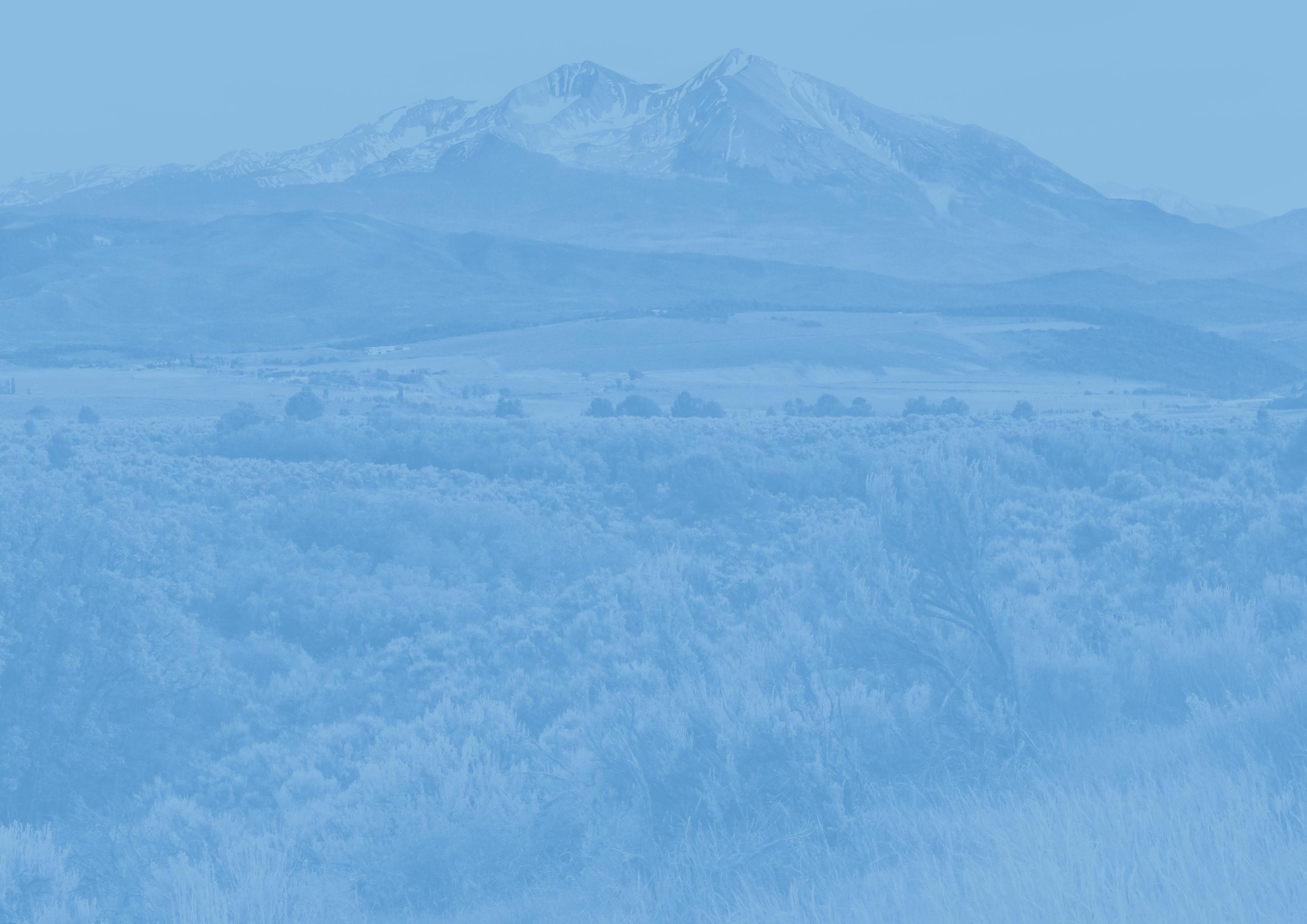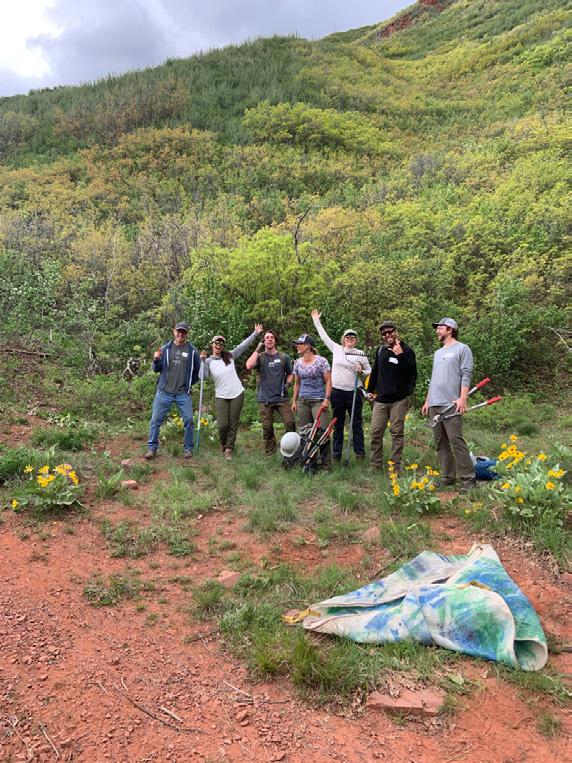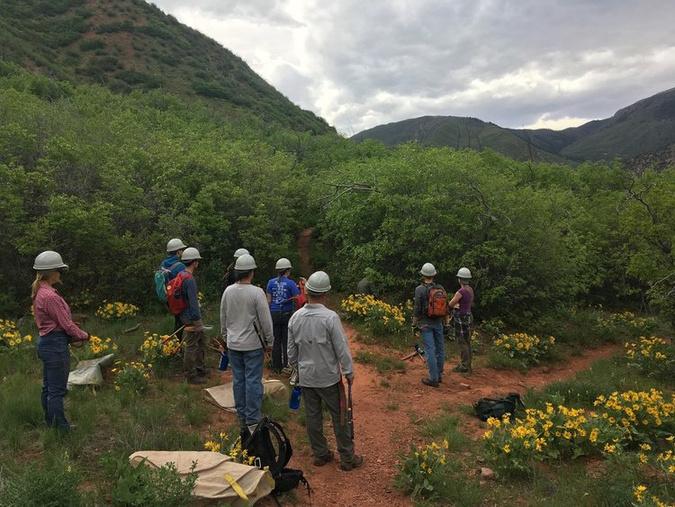




Photos by Sue Rollyson
For well over 100 years, potatoes have been harvested in and around Carbondale. The vegetable was a staple export for part of that time. Crops harvested nearby would be stored under the Dinkel Building on Main Street and brought to the surface by a lift (that is still operable today) and loaded onto freight cars at the old railroad depot to be shipped off for folks to eventually enjoy on their breakfast or dinner plates.
Today, history lives on thanks to the helping hands of a new generation. For a few years now, ahead of the annual Potato Days celebrations, Hattie Gianinetti has brought students from Two Rivers Community School to pluck spuds from the earth — just as the town’s predecessors did for the past 115 years — at the ranch belonging to her parents, Anne and Mark Gianinetti. Many thanks to the Two Rivers’ eighth grade class for helping collect this year’s lot for the community feast on Saturday, Oct. 5 in Sopris Park!

It’s a surreal experience to pick up el Sol del Valle on a Friday. Here is a full newspaper, all in Spanish, now hovering at 20 pages packed with local and regional news as well as original art and cultural anecdotes. I am delighted, turning each page and lingering on a photo or headline, making mental notes to flip back to a story later or finding myself already immersed in reading and unable to stop.
It’s surreal because nearly four years ago, in early 2021, el Sol del Valle began as a rather simple idea. “Let’s add four pages of Spanish, right in the center of The Sopris Sun, that can be lifted out and redistributed,” I thought, early into my editorship. The board was onboard and our executive director, Todd Chamberlin, offered nothing but support. It wasn’t long before Aspen Daily News sought to expand this brand into a standalone newspaper.
unlikely alliance continues meeting regularly. Now dubbed the Colorado West Spanish News Collaborative, we look forward to expanding our efforts beyond el Sol del Valle to tackle shared reporting projects and eventually, we hope, produce a radio show.

Bianca Godina and Margarita Alvarez, el Sol’s dynamic leaders, deserve so much credit for bringing the paper along — and they are not alone. These two young Latinas, born and raised in the Valley, have amassed a team including regular contributors Daniel Torres and Jackie Ramirez. Michael Perez, now a Sopris Sun board member, delivers the paper every week with meticulous care. Diane Amsden, carried through from our partnership with Aspen Daily News, brings the creative vision to life with her seasoned layout design skills. Then there’s the advisory council, a group of volunteers meeting monthly, and previous editoras Vanessa Porras and Crystal Mariscal, plus every columnist and our reliable translators, Dolores Duarte and Jacqueline Castro.
All this to say, I’ve witnessed firsthand that we are all made better in working together. The Sopris Sun benefits tremendously from the creative influence of our talented Sol del Valle team. Our humble nonprofit newsroom is elevated by sitting at the proverbial table with Aspen Daily News, Aspen Journalism, Aspen Public Radio, KDNK Community Access Radio, Radio La Tricolor, The Aspen Times and the Glenwood Springs Post Independent. And our community as a whole benefits from an informed and inspired population, properly represented.
By Raleigh Burleigh
When Colorado Media Project, a statewide initiative to empower local news, received grant applications from several Roaring Fork Valley outlets to better serve our Spanishspeaking communities in 2021, we were instead grouped into a cohort. It was somewhat like reality tv, watching leaders from all the Valley’s media hash out ways to collaborate from the confines of our Zoom boxes.
After conducting a regional survey to better understand the news needs of our Spanish-speaking neighbors, a historically underserved demographic, el Sol del Valle was declared the vehicle to continue this work. Nearly four years later, this
I want to thank the entire community for supporting High Country Volunteers’ first ever 9/11 Day of Service. We had 354 community members and 1,795 students volunteer that day for a total of 5,285.75 hours of service. Through our community-wide events we packaged and delivered 1,250 pediatric activity kits to 13 hospitals nationwide and we packaged 95,040 meals that were delivered to the Food Bank of the Rockies. It was such an amazing day!
Our 9/11 Day of Service would not have been possible without our amazing sponsors. A special thanks to: AmeriCorps, Youth Service America, Alpine Bank, Holy Cross Energy, Grand River Health, Glenwood Springs Parks and Recreation, FirstBank, Bethel Party Rentals, DJ Benny, Walmart and Target. We’re already looking forward to hosting the event again next year. Thank you!
Mary Moon Carbondale
While the internet has long allowed misinformation to proliferate, the problem is even worse now with the advent of Artificial Intelligence (AI) generating misinformation that is starting to overwhelm the internet. This misinformation is coming from both the right and the left. This is all
We are beyond grateful to Aspen Daily News for partnering with us to bring Sol del Valle to where it is today. Their investment in this vision and continued commitment to news equity signal a business rooted in ideals. The decision to absorb production and distribution of that brand back under The Sopris Sun umbrella was catalyzed by a study commissioned by Colorado Media Project earlier this year.
As our executive director will tell you, it isn’t a light lift. Embracing the responsibility of carrying forth the Sol del Valle torch will add hundreds of thousands of dollars to our annual expenses. While it also expands ad sales and grant opportunities, we will continue to depend on donations to bridge the gap.
As a 501(c)(3) nonprofit, The Sopris Sun is more than a newspaper. We are a mission-driven institution, informing, inspiring and building community by fostering diverse and independent journalism. Sol del Valle has become a big part of meeting that mission and is complemented by our weekly training program for high schoolers interested in becoming journalists.
And we couldn’t do what we do without you. Help prove the merit of hyper local news informed by community voices by donating today at www.soprissun.com/donate or send a check to PO Box 399, Carbondale CO 81623
tied to the ability to inspire fear in the readers (something that AI-generated content is particularly good at), prompting them to click on links to get even more fear and validation of that fear. The constant clicking of links can up the advertising revenue of social media providers, or it could serve the purpose of foreign powers seeking to destabilize our democracy. In either case, the outcome is bad.
So how do you break this cycle and get accurate information? By getting your news from reliable news sources, not social media.
What are reliable news sources? Sources that actually check the factual accuracy of content before publishing it. How do you know which sources do that? Newsguardtech.com is an organization (founded by journalists) that provides that service by vetting the factual accuracy of news sources. Before you think this is a left wing ploy, please note that they do it for both left and right leaning news sources and there are good and bad ones on both sides. They are rated on a scale of 0 to 100, with 100 being the best.
Here are some credible news sources with scores of 85 to 100: Wall Street Journal, Washington Post, Los Angeles Times, Denver Post, NBC News, The National Review, Christian Science Monitor, CBS News, New York Times and The American Conservative.
Some not so reliable news sources with scores between 65 and 80: ABC News, New York Post and Fox News
And some unreliable news sources with scores under 50: MSNBC and Breitbart. I urge you to unplug from your social media accounts and go to these news sources with scores of at least 80 or better instead. And sample both sides (I regularly read the Washington Post and the Wall Street Journal).
Jerome Dayton Carbondale
Have you wondered why Perry Will is not talking about his voting record?
“I don’t want to get into the whole library thing; that’s a huge issue,” Will, Garfield County District 2 commissioner candidate, said in a recent interview with The Sopris Sun. Apparently he doesn’t want to get into this huge issue because his position is not popular with voters here.
Will voted against the recent bill to protect Colorado’s libraries against partisan book bans (SB24-216). He also agreed with the county commissioners’ decision to take control over the process of selecting trustees for our library board. Will has a boatload of unpopular and extreme votes that he would probably prefer we not know about. He voted
Editor Raleigh Burleigh 970-510-3003
news@soprissun.com
Contributing & Digital Editor
James Steindler
Sol del Valle Editora Bianca Godina bianca@soprissun.com
Lead Editorial Designer Terri Ritchie
Advertising Designer
Emily Blong
Delivery
Frederic Kischbaum
Hank van Berlo
Bartlett
Proofreaders
Lee Beck
Tracy Kallassy
Ken Pletcher
Hank van Berlo
Executive Director
Todd Chamberlin 970-510-0246
adsales@soprissun.com
Board Members / Mesa Directiva board@soprissun.com
Klaus Kocher • Kay Clarke
Lee Beck • Donna Dayton
Eric Smith • Roger Berliner
Elizabeth Phillips • Jessi Rochel
Andrew Travers • Anna Huntington
Michael Perez • Loren Jenkins
The Sopris Sun Board meets at 6pm on second Thursdays at the Third Street Center.
The Sopris Sun, Inc. is a 501(c)(3) nonprofit corporation with a mission to inform, inspire and build community by fostering diverse and independent journalism. Donations are fully tax deductible.
Sincerest thanks to our Honorary Publishers for their annual commitment of $1,000+
Lee Beck & John Stickney
Kay Brunnier
Frances Dudley
Michelle & Ed Buchman
Sue Edelstein & Bill Spence
Deborah & Shane Evans
Greg & Kathy Feinsinger
Gary & Jill Knaus
Eric Smith
Peter and Mike Gilbert
Patti & George Stranahan
Elizabeth Wysong
Alpine Bank
Emily & George Bohmfalk
Kathy & Carter Barger
Sandy & Paul Chamberlin
Karen & Roger Berliner
Donna & Ken Riley
Gayle & Dick Wells
Legacy Givers for including us in their final wishes. Mary Lilly
Donate by mail or online: P.O. Box 399 Carbondale, CO 81623
520 S. Third Street #26-B 970-510-3003 soprissun.com/Donate
The Sopris Sun, Inc.
is a proud member of the Carbondale Creative District continued on page 22






Cool Bricks Studio
Aspen Valley Hospital
Colorado Mountain College
Hillary Porterfield
Carbondale Rotary
Basalt Library
Colorado Animal Rescue
Carbondale Arts
Interested in becoming an Underwriter or Nonprofit Partner in 2024? Email Todd@soprissun.com or call 970-987-9866
Well folks, it’s no secret, Carbondale’s 115th Annual Potato Day kicks off this Thursday, Oct. 3, with a viewing of “Red Stallion in the Rockies” — filmed locally 75 years ago — at the Carbondale Library at 7pm. Carbondale Parks and Rec put together a fabulous brochure with event details, volunteer opportunities (including potato wrapping at Thompson Park preceding the movie screening on Thursday) and general information. Check it out at www.tinyurl. com/PotatoDaysBrochure and have a spud-
Pitkin County Open Space and Trails is accepting proposals to lease a three-acre tract of irrigated land at Glassier Open Space for $25 per acre annually. Applicants have the option to request one to three acres to lease. A mandatory pre-proposal meeting and site visit for prospective bidders will take place Oct. 18 at 10am. For details, visit www.bit.ly/Glassier
Garfield Clean Energy and local utilities are offering to help residents winterize their homes and lower their energy bills via free coaching and discounted home-energy audits this October ($50 — or free if income qualifications are met). “On top of that, having the audit done makes you eligible for rebates that will help pay for the recommended improvements, which in turn will lower your monthly bills for years to come,” stated Zuleika Pevec with Clean Energy Economy for the Region. A $500 Lowe’s gift card prize drawing sweetens the deal. Any Garfield County resident can sign up at www.GarfieldCleanEnergy.org
Valley View celebrated receiving a fivestar rating for overall hospital quality from the Centers for Medicare and Medicaid Services on Oct. 3. The 2024 ratings are based on hospital performance across 46 quality measures and Valley View is one of 17 hospitals in Colorado to receive the designation.
Forbes magazine published an article last week listing the U.S. cities where home values have grown the most over the past 20 years, from 2004 to 2024. Based on data from Zillow’s home value index, Carbondale was ranked number one with the median home value jumping from $256,998 in 2004 to $1,440,404 today — a 460.5% increase. Rifle
Consider

also made the list at number 13, with home values climbing from $109,019 to $479,433, and Glenwood Springs sits at 19, from $211,576 to $916,937. Boone was the only other Colorado city in the top 20.
Beginning this December, Frontier Airlines will fly to the Eagle County Regional Airport with nonstop service to Denver, Dallas and San Francisco. “Frontier is thrilled to connect consumers in Colorado, Texas, California and beyond with the incredible beauty, world-class skiing and endless recreational opportunities this area of Colorado is famous for,” stated Jennifer de la Cruz, senior director of corporate communications with Frontier Airlines.
The Colorado Division of Reclamation, Mining and Safety (DRMS) proposed a nearly nine-time increase to the reclamation bond for Rocky Mountain Industrials’ (RMI) limestone quarry outside of Glenwood Springs. Since 2019, RMI’s bond has been $366,179, but the proposed increase, as is, would jack that up to $3,251,767. A rockslide at the quarry in January 2023 prompted the increase. The purpose of the bond is to ensure that the state and feds, should RMI abandon the mine, would have sufficient funds to stabilize the slope. Should it come to that, rock bolting is likely the most effective means to stabilize
Email Todd@soprissun.com or call 970-987-9866
two layers of limestone above the quarry. DRMS invited RMI to obtain three additional rock bolting estimates by Oct. 25 to potentially offset the cost. Once the bond amount is set, DRMS will give RMI 60 days to increase its financial warranty to cover the new bond.
Summit54’s after school tutoring program is back in action! Elementary school students who test below their grade level are eligible for this free one-hour tutoring opportunity conducted at Roaring Fork School District elementary school classrooms every Monday, Tuesday and Thursday immediately after school. The schedule mimics the district’s academic calendar, so no tutoring will be offered during winter or spring breaks. Stepping into its fifth year, Summit54 has benefited more than 10,000 in the Valley since its inception. For more info, visit www.summit54.org
They say it’s your birthday!
Folks celebrating another trip around the sun this week include: Matt Koenigsknecht, Jill Rubin and Mac Scott (Oct. 4); Lisa Girardot, Morgan Neely, Jessi Rochel and Tami Stroud (Oct. 5); Bill Anschuetz, Christi Couch and Matthew Roeser (Oct. 6); Bob Burns, Iliana Rentería and Camille Vogt (Oct. 7); Jody Ensign, Lani Kitching and Bo Persiko (Oct. 8); Sarah Graf, Sarah Morehouse and Melissa Nelson (Oct. 9); Charlotte Vanderhurst (Oct. 10).


ANNALISE GRUETER
Sopris Sun Correspondent
This Saturday, Oct. 5, the who’s who of Colorado outdoor athletes and safety experts converge on The Art Campus at Willits (TACAW) from 11am to 5 pm. Aspen Public Radio and TACAW present the first annual Backcountry Symposium, starting with a resource fair, following Aspen Valley Ski & Snowboard Club’s (AVSC) Community Sports Swap just a few blocks away. Fifteen organizations will be available to share information about avalanche safety, gear choices, eco-conscious travel, literature resources and more.
Local businessman
noticed as they settled into the valley is that parenting kids here can entail different safety considerations than elsewhere. While there already are trainings and opportunities for skill development, more conversation may be needed when it comes to proper know-how, comfortability and, of course, safety.
“Hopefully this event can help people differentiate between legitimate safety practices versus social media presentation.”
“The level of knowledge and experience in this Valley is amazing,” he continued. Having learned at the hands of Valley experts himself, like Aspen Expeditions’ Britt Ruegger, McBride hopes that community members come to connect and listen.
It should come down to respect, communication and the concept of the veto. If someone becomes uncomfortable, does the group have a plan of what to do?
Sam McBride and his family moved to the Roaring Fork Valley during the pandemic. As they have become better acquainted with local recreating opportunities, “[It] got me thinking about my own passion for the backcountry and what I’ve learned from members in the community,” he shared. “More and more people are recreating in the backcountry … but not very many formal opportunities for knowledge-sharing exist.”
Organizers hope the event will attract families from the AVSC swap. A key thing the McBrides
- Lou Dawson
From noon onward, that’s exactly what the Backcountry Symposium aims to fulfill. Through a series of conversations around wilderness safety, communication and decisionmaking, the event consolidates local experts’ knowledge.
“A lot of people get out and start doing things without knowing how much more they could know about an activity,” said McBride.
“I’ve learned so much from the Aspen Expeditions team. Seeing how they plan and prepare throughout the season has really impacted how I think about my own excursions.”
If there’s someone who knows about planning excursions, it’s Lou Dawson, prolific guidebook author and the first person ever to ski all of Colorado’s 14,000-foot peaks. He and fellow Colorado skiing icon Chris Davenport will close the Symposium with a keynote conversation. Their interview will center around Dawson’s recently released memoir, “Avalanche Dreams,” and dive into the nuts and bolts of backcountry and avalanche safety.

“Backcountry skiing is really always a team building exercise in of itself, and should be thought of as such,” says Lou Dawson. Photo, courtesy of Annalise Grueter, taken while in the backcountry with friends in 2019.

Dawson has been involved in outdoor risk evaluation and
continued on page 18
“The goal of any good backcountry preparedness seminar should be to have something for everybody,” said Dawson. Both Valley locals, Dawson and Davenport plan to touch on mountain living and raising families in the mountains. Good communication and knowledge-sharing are essential to Dawson, who emphasized that such practices also increase the possibilities of what families can do together. “You can do ski touring and backcountry exploration even with small kids, it just takes thought and consideration,” he stated.
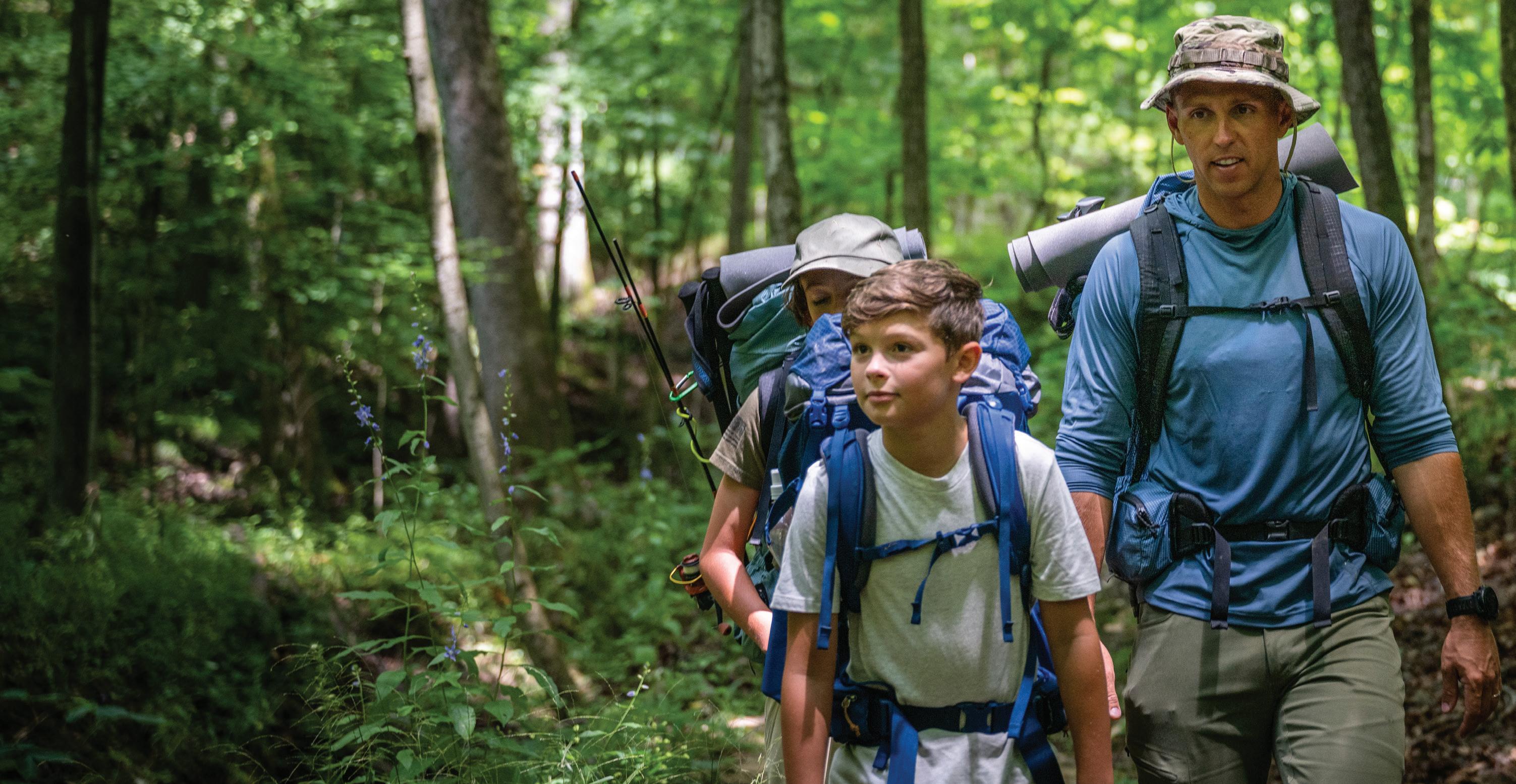
JOHN STROUD Sopris Sun Correspondent
Tempest Manthei is just the kind of person that the West Mountain Regional Housing Coalition (WMRHC) had in mind when it launched its “Good Deeds” housing buy-down program on a pilot basis earlier this year.
On Sept. 20, Manthei became the first beneficiary of the program when she closed on her new home in Glenwood Springs.
program and its contribution has changed the trajectory of my life for the better.”
WMRHC is already on track to tell more of those stories in this first year of the program, which local government leaders from Aspen to western Garfield County hope to continue and expand upon in future years.
The ability to stay in Glenwood,
and to be able to live and work and play and attend my children’s sports and school events, all in the same town, is priceless, - Tempest Manthei
The Valley View Hospital nurse and single mom said it couldn’t have happened without the 30% contribution toward the home purchase price from the WMRHC’s Good Deeds fund.
“The ability to stay in Glenwood, and to be able to live and work and play and attend my children’s sports and school events, all in the same town, is priceless,” Manthei said in a news release announcing the first buy-down under the program.
“I have a wonderful job, but realistically, I was not going to qualify to buy a home in Glenwood as a single mother with my income,” she continued. “The
Four additional homes are under contract and more are in process, providing hope to other professionals in the commu nity, including a school adminis trator, a nonprofit employee, an HVAC technician, a landscaper, a chil dren’s social worker and a local govern ment employee, that they will be able to secure a home in the region’s tight and extremely expen sive housing market, WMRHC Executive Director April Long said.
The demand is high for prospective homebuyers who are employed locally to obtain some assistance in buying a home — especially those who fall outside income requirements or are on long wait lists for other affordable housing programs.


“You have to attend one of our webinars in order to apply, and so far I’ve had over 40 people at each of the three webinars that I’ve hosted,” Long said.
That has in turn resulted in 75 requests for applications, she said.
To qualify, a buyer must prove that they work for a locally based employer and are not working remotely for an outside company, and agree to having a deed restriction placed on the property.
The Good Deeds program is being offered for the first year after $2 million in funding was provided by local
governments, including $1 million from Pitkin County, $450,000 from Aspen, $250,000 from Snowmass Village, $200,000 from Glenwood Springs and $100,000 from Carbondale.
With that, WMRHC is able to provide 30% of the cost to purchase a home that falls within a certain price point — up to $1.2 million in Carbondale/Glenwood Springs, $1.5 million in Basalt, Snowmass and Aspen and $800,000 in western Garfield County.
In turn, a deed restriction is placed on



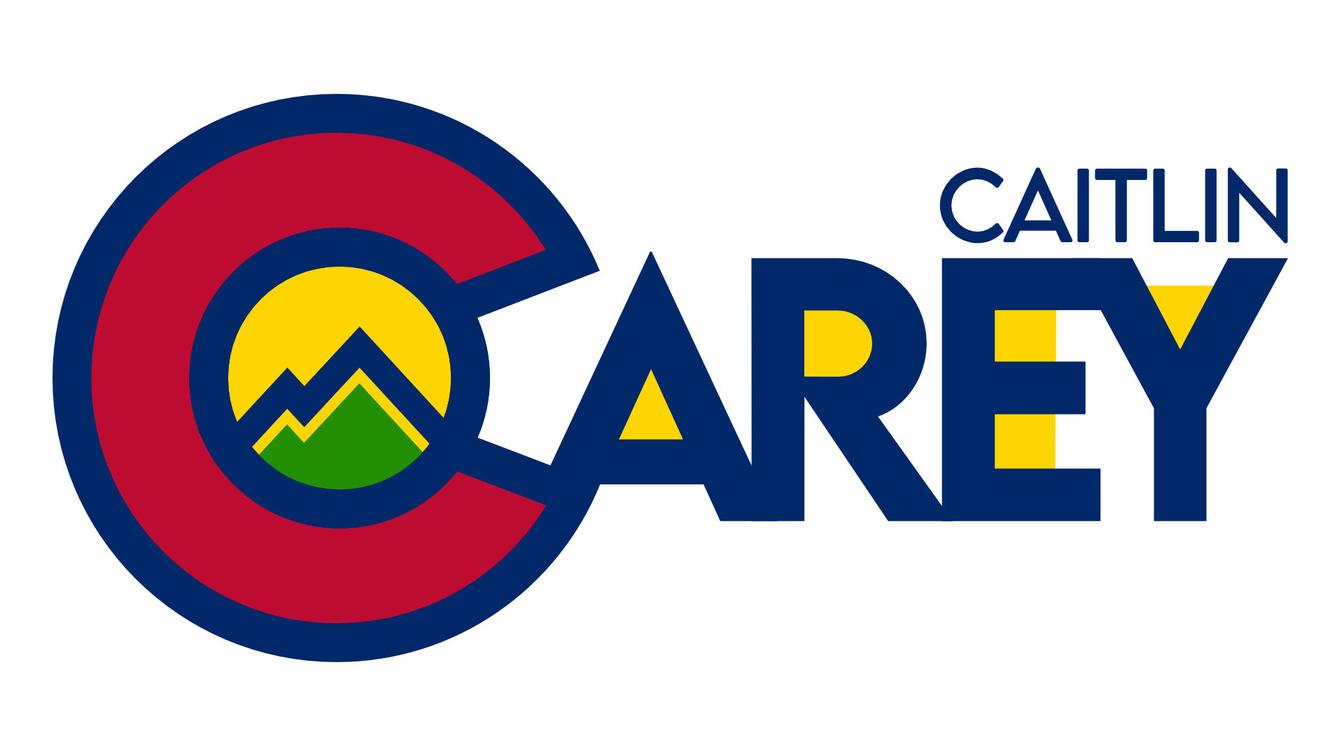
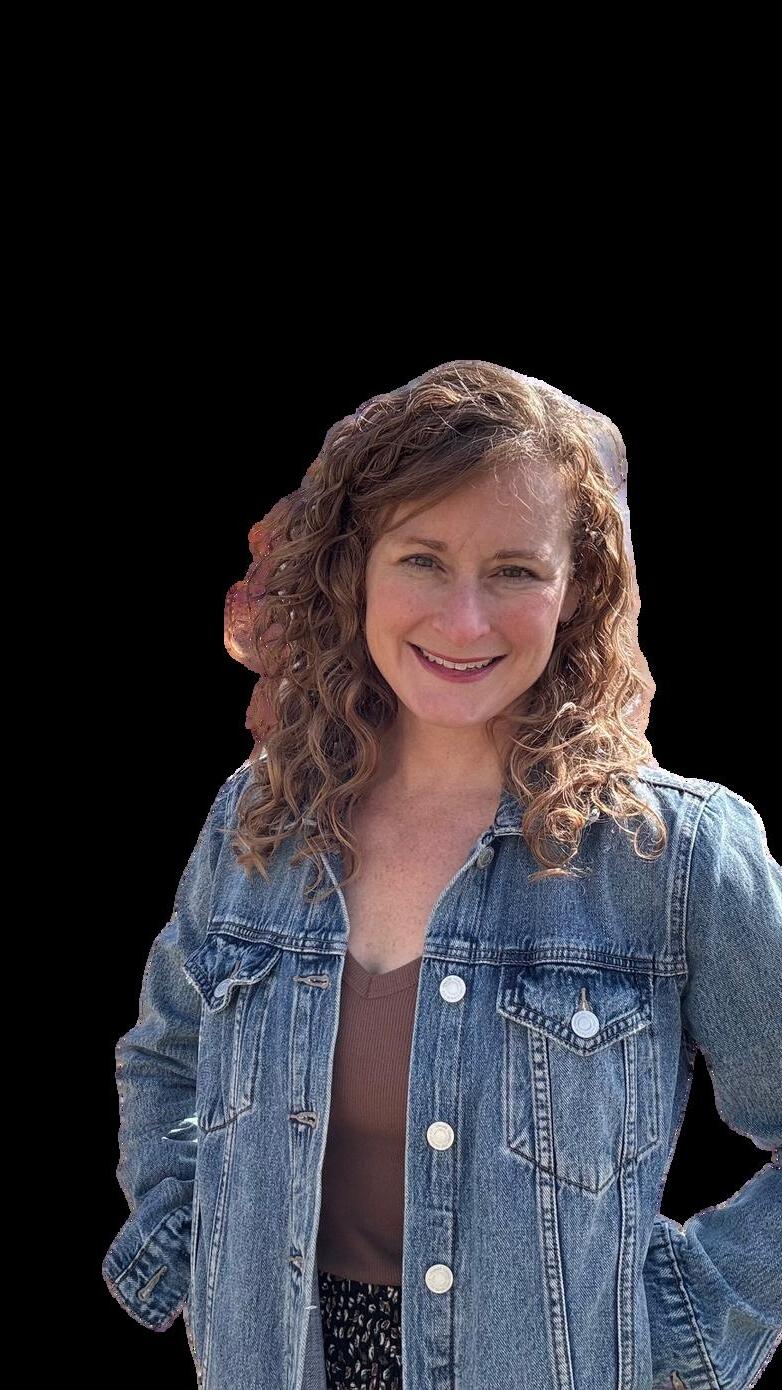

JEANNE SOULDERN
Sopris Sun Correspondent
For many, the experience of pregnancy can vary significantly. While one pregnancy may be smooth, others may bring complications such as gestational diabetes, high blood pressure, preeclampsia or preterm labor, requiring more intensive care and monitoring.
Accessing adequate maternity care is a challenge in rural communities like Garfield County. The Maternal and Child Health Program, administered by the Colorado Department of Public Health and Environment, aims to improve the health of mothers, children and families across the state. However, many rural communities still face significant barriers.
The term “maternity care desert” was coined in the early 2010s to describe regions where access to maternity care is severely limited or nonexistent, particularly in rural areas. These communities often lack hospitals or providers capable of delivering maternity services, forcing pregnant individuals to travel long distances to receive care. A 2022 study by the U.S. Department of Health and Human Services highlighted geographic areas most affected by this issue.
The American College of Obstetricians and Gynecologists (ACOG) recommends beginning prenatal care within the first 6-8 weeks of pregnancy, followed by regular checkups every four weeks until 28 weeks, then increasing frequency as the due date approaches. However, the need for nearby providers can make adhering to this schedule difficult in rural areas.
Despite the best plans, long travel distances sometimes lead to emergency roadside births, particularly for those living far from hospitals. A search for hospitals within a 60-mile radius of Carbondale revealed two facilities: Valley View Hospital in Glenwood Springs (12 miles away) and Aspen Valley Hospital (28 miles away). Both hospitals have Level II neonatal intensive care units (NICUs).
While Level II NICUs manage stable, moderately premature infants requiring some support, Level III NICUs care for critically ill or extremely premature infants needing complex, intensive care.
The closest Level III NICU to Carbondale for more advanced neonatal care is at St. Mary’s Hospital in Grand Junction, approximately 85 miles from Carbondale. A Level III NICU is equipped to provide intensive care


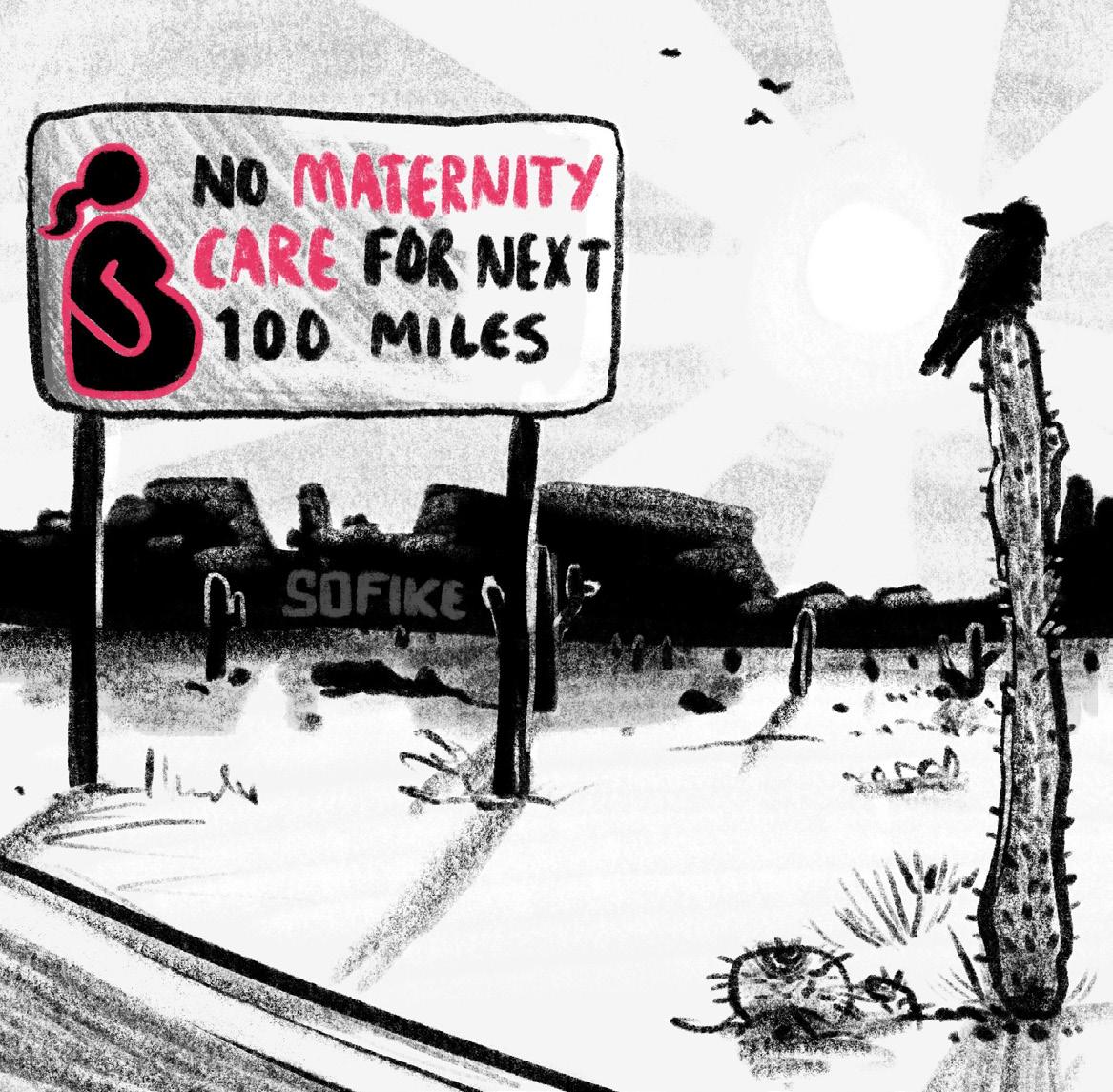
for critically ill or very premature newborns, typically those born earlier than 32 weeks gestation.
However, maternity care patients are typically airlifted to a higher-level care hospital in the case of preterm labor or birth, fetal distress and in cases where the mother or child is experiencing life-threatening conditions.
These longer travel distances can increase maternal and infant
health risks. According to the 2024 “Nowhere to Go: Maternity Care Deserts Across the U.S.” report by March of Dimes, nearby counties like Rio Blanco and Grand are considered maternity care deserts, while Delta County has “low access to care.”
Efforts are underway to address these challenges. In September 2023, the University of Colorado College of Nursing
received a $2 million grant from the Health Resources and Services Administration (HRSA) to expand the rural midwifery workforce. This initiative supports students who commit to practicing in rural communities after graduation, to improve access to maternal care.
In 2022, Gov. Jared Polis signed House Bill 22-1289, which expanded Medicaid postpartum coverage from 60 days to 12 months. This expanded coverage offers crucial support for new mothers, particularly in rural areas where ongoing healthcare can be difficult to access. The hope is that such initiatives will encourage more healthcare providers to offer services in rural communities, ultimately improving access to comprehensive maternity care.
While progress is being made, there is still a significant need for better maternity care options in rural communities. Expanding services and support for mothers and babies remains critical to improving outcomes in regions like Garfield County.
For more information and a map showing maternity care deserts by county, visit the March of Dimes webpage at www.marchofdimes.org/ maternity-care-deserts-report







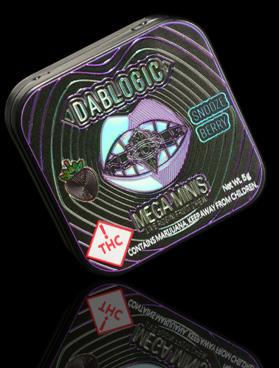

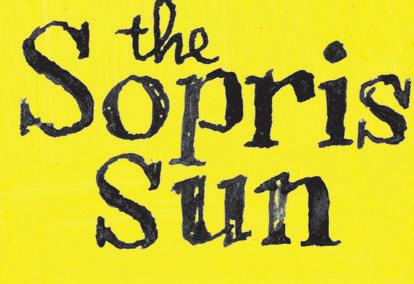
JEANNE SOULDERN Sopris Sun Correspondent
Colorado Proposition 131, the TopFour Ranked-Choice Voting (RCV) Initiative, will be on the ballot in the Nov. 5 election. If approved by Colorado voters, Proposition 131 would go into effect for the 2026 election cycle.
The ballot measure would significantly change Colorado’s election process if passed by the voters. The measure proposes a shift to a nonpartisan primary system in which all candidates, regardless of political party, compete in a single primary open to all voters. The top four candidates would then advance to the general election, employing a rankedchoice voting selection of the winners. This method would allow voters to rank candidates in order of preference, with the winner needing a majority of votes to be declared.
RCV, sometimes known as instant runoff voting, would be implemented in elections for the U.S. Senate, U.S. House of Representatives, governor, attorney general, secretary of state, treasurer, Colorado University board of regents, state board of education and the state legislature.
RCV has been adopted in several states and cities. Maine and Alaska use RCV for statewide elections, and New York City, San Francisco, Minneapolis and Oakland are some prominent cities that use it in local elections. Only a few Colorado
municipalities, such as Boulder, Fort Collins and Telluride, have adopted RCV for their local elections.
The city of Aspen initially adopted RCV in 2007, implementing it for the 2009 municipal election. However, after significant public dissatisfaction with how the system functioned, voters repealed RCV in 2010, only a year after its first use. The repeal was supported by 65% of voters, primarily due to frustrations over the logistics and complexities associated with the system’s implementation
The ballot measure’s title indicates that the four candidates who receive the highest votes in the June primary will advance to the November general election. These top candidates can belong to any political party, thus eliminating party-line primaries.
In our voting hypothetical, voters face a crowded field after an open primary in June. Among the top four candidates emerging from the primary are James, Nancy, Candace and Lee — the first three are Republicans, and the last is a Democrat.
The general election ballot features all four candidates in November. Voters will rank them in order of preference: 1 through 4.
Round 1: On Election Day, only the top choice from each ballot is initially counted. Lee receives 35%, Nancy 32%, Candace 22% and James 11%. Since no candidate secures a majority, James, the








lowest vote-getter, is eliminated.
Round 2: Votes for James are redistributed to the next preferred candidates of his supporters. After this reallocation, Lee leads with 38%, followed closely by Nancy at 37%, and Candace at 25%. Again, there’s no majority, so Candace is eliminated.
Round 3: Candace’s votes are reallocated, resulting in Nancy receiving an additional 16% and Lee 9%. The final count shows Nancy with 53% and Lee with 47%. Despite trailing initially, Nancy wins, reflecting her broader support among voters.
Colorado Voters First, a political organization that advocates for electoral reform, supports a ‘yes’ vote on Prop. 131. According to their website, “Any voter should be able to vote for any candidate in any taxpayer-funded election.”
They suggest that support for the ballot measure could enhance voter interest in primaries, increase satisfaction by allowing preferences for multiple candidates and ensure that elected representatives have broader support among the electorate.
First Choice Counts is a nonprofit organization focused on advocating for voters to cast ‘no’ votes on Proposition 131, arguing that it complicates elections, undermines voter clarity and risks reducing voter turnout. They advocate for simpler voting processes that enhance democracy without introducing rankedchoice systems.
To vote in the 2024 General Election in Colorado, you must meet the following criteria: be 18 years of age or older by Election Day, be a United States citizen, have resided in Colorado 22 days immediately before the election at which you intend to vote (Mon. Oct. 14, at the latest) Not currently serving a sentence of confinement or detention for a felony conviction.
You may register to vote at any time up to and including on Election Day. You can do so on the Colorado Secretary of State’s website or in-person at a Voter Service and Polling Center. If you want to receive a ballot by mail for the 2024 General Election, you must register no later than Monday, Oct. 28. Starting Monday, Oct. 21, you can visit a Voter Service Center in your county to register and vote through 7pm on Election Day when polls close. According to the Garfield County Clerk and Recorder’s office, ballots will be mailed to all eligible voters on Friday, October 11.


“It’s hard to tell your
‘no’ but it’s really hard to tell your friends ‘no’”
AMY HADDEN MARSH
Sopris Sun Correspondent
Republican Mike Samson has served as a Garfield County Commissioner for 16 years. He is running again to represent District 3. This interview was edited for length and clarity.
What have been the Garfield County commissioners’ two best decisions in the past four years? And how were these decisions in the best interest of the county?
Mike Samson: The Flying M decision was tough because we need housing. There were a couple things that I really wrestled with. The number one thing that stood out to me was the traffic. The second thing was teacher housing and the cost for rent. I’m saying to myself, teachers aren’t going to be able to afford this.
A super good [decision] was to get the Center of Excellence at the airport. [It’s] main purpose is to do experimentation and investigation and research into fighting fires, specifically, nighttime firefighting.
Another tough one was the Ascendigo decision. Very controversial. I mean, good people with good intentions. It is a personal note to me because I have a grandson who is severely autistic. I try to get along with people. I try to work with people. But sometimes you gotta be a tough S. O. B. I heard a guy say once, it’s hard to tell your enemies “no,” but it’s really hard to tell your friends “no.”
Every decision I make, I ask “the guy up there” to help me. And I always, in the end, try to say, what’s the best for Garfield County?
What issue in the county do you think needs more attention?
A lot of people come before us with two concerns and to me, they’re intertwined: economy and housing. I want to have the economy improve in a lot of ways. One is good paying jobs, which brings me to natural gas. I’m a proponent of natural gas, always have been, always will be. Those people working in the natural gas field made good money.
When I was on the Rifle City Council back in the late ‘70s and early ‘80s, we had the Exxon bust. Black Sunday. May 2, 1982. You know what [Exxon] did? They had the morning shift coming in to work. They hired private security guards and they told people at the gate, turn around, go home, you’ll receive your last check in the mail, you no longer have a job. It screwed up the economy from Grand Junction to Glenwood Springs. Parachute was devastated. Rifle was devastated, the whole nine yards. From 2008, for the first four, six years, did Garfield County have a lot of money? Yes, we did. Why? The tax revenues coming in from natural gas. We don’t have the money we used to have.
How can Garfield County diversify in light of the fact that natural gas is in a slump right now?

What have we been doing out at the airport? That was my pet project. I grew up with that. I remember going out to that airport and seeing those planes on that dirt runway and just being amazed. The main thing they did then was crop dusting. Slowly but surely, we’ve gone from the mom-and-pop airport to where we’re at right now, but you ain’t seen nothing yet. I don’t want just hangars; I would like to see many things come in there. Garfield County’s got land out there that we could sell to “Company X” that’s going to manufacture whatever widget it is. Maybe somebody would come in there and build something that the aviation industry needs. Good paying jobs so people can have nice houses.
Garfield County is now a non-sanctuary county. You drafted that resolution. Why?
This is how I look at immigration: I
don’t want anybody to starve. I don’t want anybody to freeze. We said “no” to the $50,000 that Carbondale requested of us. And that’s what I told them, I said, guys, I got homeless, I got vets, I got old people that are not making it. I got young families. I can’t give $50,000 to you guys to take care of people that just came here when I got all these other people to take care of.
I think one of the major problems in the United States right now is illegal immigration. There’s millions of them and that’s draining resources.*
I take my little 5-year old grandson [to pre-school]. About a month after we passed the resolution, a Latino lady driving this nice pickup rolled down the window and said, “Commissioner Samson, you did the right thing, passing that non-sanctuary status.” Then, she says, “The problem is the people that have come here legally and got their status and have their jobs and are paying their taxes, don’t like it.”
You have millions of people coming in and just gimme, gimme, gimme. We cannot continue to do this. You’re overloading the system.
How do you approach working with someone whose political views differ from yours?
I try to get them to understand that you’re not going to get everything you want or I’m not. But hopefully we can compromise. I have found in my lifetime, as a high school teacher, as an administrator, as a county commissioner, and all the boards I’ve sat on, being a father of seven,
continued on page 22


ELIZABETH KEY Sopris Sun Correspondent
A few weeks ago, I went to call for my dog and discovered a rifle-toting, camouflage-clad hunter just beyond my porch. I started yelling, “Hey, hey—” stumbling to find words as he took to the woods along the community path. I stopped short, deciding I was barking up the wrong tree by yelling at a man with a deadly weapon. Instead, I called Colorado Parks and Wildlife (CPW) to report the incident. I was a gowk when my assumption of residential buffer zones was proven false. CPW informed me that my unincorporated neighborhood of Redstone was fair game as long as the huntsman did not cross my property line.
Don’t move next to an airport and complain about noise pollution, I thought, and don’t move to a neighborhood bordering happy hunting grounds and complain about the man outside your door with a gun. Feeling vulnerable, my first reaction was to fashion my family in bright orange for the fall season, and my second was to leave no stone unturned to educate myself on the rules and regulations of hunting season.
I was reassured to discover that hunting within 50 feet on each side of the centerline of any state highway or municipal county road is illegal. Also, the U.S. Forest Service website states that “discharging a firearm (including a bow and arrow) is prohibited in or within 150 yards of a developed recreation site, a residence, or any place where people are likely to be.”
CPW also offers Wildlife Hunter Education Courses year-round to prevent shooting from the hip, so to say. The courses are a requirement for anyone who wants to apply for or buy a Colorado hunting license. They cover various topics, including firearm safety, wildlife management and hunting regulations.
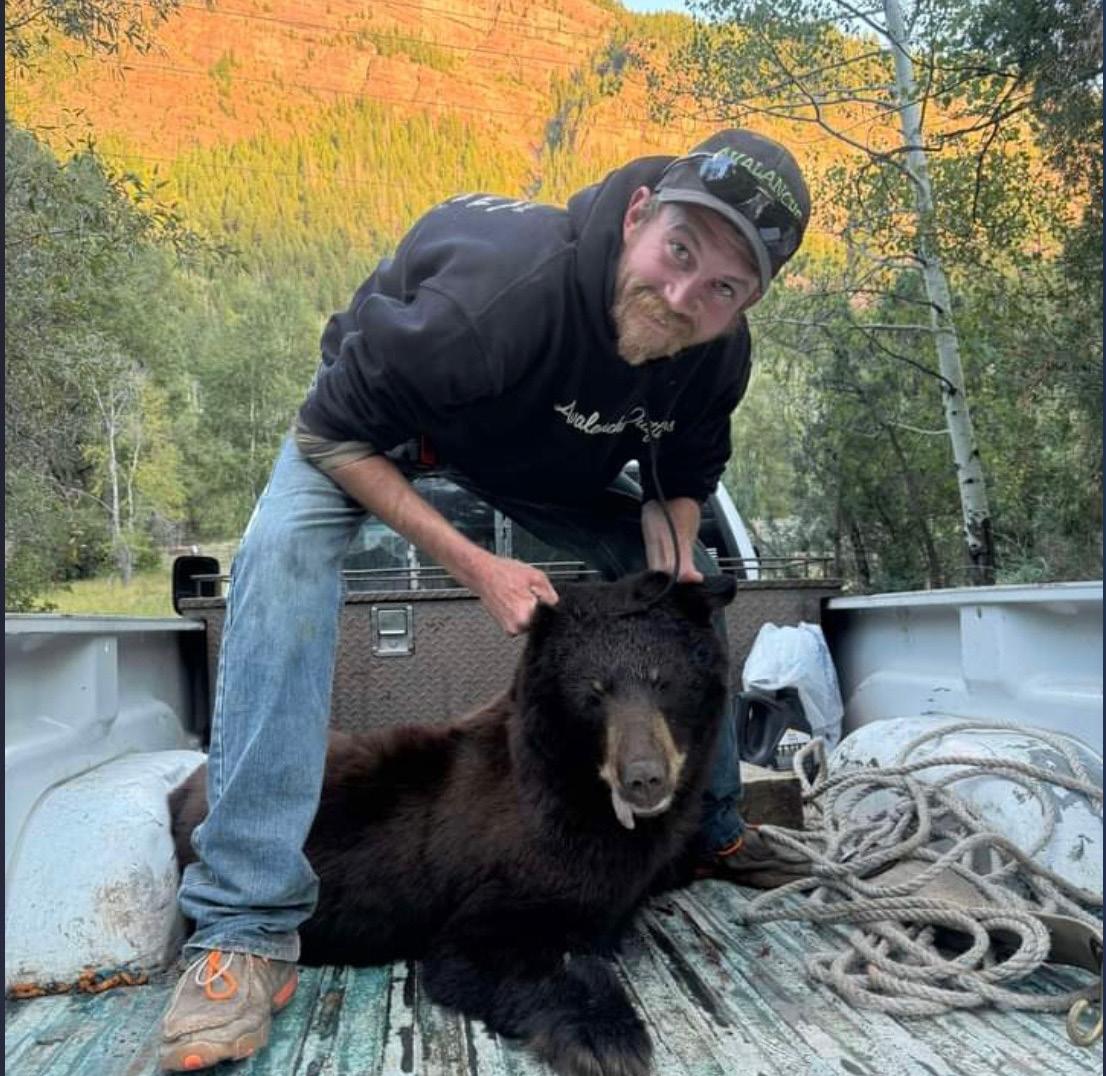
While I continued to tunnel down the rabbit hole online, I decided I needed our resident expert to flush out my understanding. Josh Wamboldt owns Avalanche Outfitters in Redstone, located just beyond the coke ovens.
Wamboldt said, “Every tag is dependent on the manner of take, which is archery, muzzleloader or rifle. For this area, we have bear, moose, mountain goat, bighorn sheep, mule deer and elk. Each tag is dependent on the season you are hunting, so the first rifle season is for bears or elk only, so you could only have a bear or elk license to hunt that season.”
Tags are awarded through a draw system or over the counter from any licensed agent, such as the Roaring Fork Coop in Carbondale. The system favors residents over non-residents. For example, 75% of the licenses are awarded to residents and 25% to out-of-state hunters. Also, elk tags cost $60 for locals and $800 for visiting hunters. If all tags are not drawn, there is a secondary draw with a youth preference. The remaining tags go on a leftover list and are available over the counter.
Wamboldt continued, “You can technically hunt one
male and one female each year of each species.” He said, “If you are hunting [on] private land, there are over-thecounter tags for this area.”
Hunting is used for conservation and population control, and trophy hunting is illegal, as well as killing mothers, called “sows,” with cubs. Five-year population estimates determine the number of licenses, adjusting for large species die-offs. CPW monitors by requiring hunters to bring in the hide, skull and meat of animals such as bighorn sheep, mountain goats, bears, mountain lions and moose to have them checked for age, sex and to certify the meat was harvested correctly. The process is not mandatory for elk and deer, but hunters must harvest all edible meat and antlers.
Bears weigh an average of 200 to 300 pounds. Wamboldt makes hamburgers, tacos, chili, roasts and stews from the meat. Most wild game has a “gamey” flavor and lacks much marbling, requiring low-temperature cooking. The most popular hunt is elk, but mountain lion meat is considered a delicacy due to its sweet, pork-like flavor.
Wamboldt sees two to three mountain lions a year on the mountain but has also witnessed one walking down Redstone Boulevard. They are regularly caught on home security cameras. Mountain lions are rarely hunted outside Redstone due to the winter hunting season and terrain. They are more often hunted toward Carbondale.
Wamboldt said of his recent bear hunting, “We’ve harvested with my company three sows and one boar [male]. None of these sows that we harvested had any cubs with them. One of the sows we harvested was estimated to be over 18 years old. The other one was estimated to be 6 years old and had never been bred. We also harvested a 3-year-old bear that had never been bred either.” He said, “The boar was over 400 pounds. We believe he was the one that was flipping dumpsters over in Redstone and wreaking havoc.”
My attempt to run with the hare and hunt with the hounds helped quell my fear. As Francis Bacon said, “Knowledge is power.” Remember, the first rifle season, elk and bear only, is from Oct. 12 to Oct. 16.
For more information, please visit www.cpw.state.co.us















Sopris Sun Correspondent
Signs of fall are everywhere, and while the urge to clear cut and tidy up your garden is strong, consider following nature’s slow approach to winterizing.
Simply put, winterizing is the act of protecting plants from harsh seasonal elements, rejuvenating soil health and removing any diseased or unwanted plant materials (looking at you, water hemlock). In nature, wildlife consumes decaying plants, fallen leaves build insulation and birds help reseed the land. By working with this natural cycle, the plants, soil, wildlife and your back all benefit.
“You really want to maintain your soil and plants’ health throughout the winter,” said Julie Collins, co-owner of The Flower and The Bean. “A lot of my annuals naturally die back. I don’t cut them down or move them, I just leave them. In the spring, anything that has not broken down into the soil will be cut off, but I leave the plants’ roots because it helps refortify the soil.”
For perennials that require maintenance, Collins waits for a few hard frosts before trimming. This method helps plants go to seed for reseeding and provides food for beneficial insects and birds. Some perennials like milkweed can remain standing overwinter to provide a habitat for pollinators.
“We’re so anxious to clean up our gardens, but that fall mess of the plants dying is the balance of nature,” said Collins.
As the plants begin to decay, Adrian Fielder, assistant dean of instruction at Colorado Mountain College, reminds us that insulation is a key task for winterizing. Biomass materials such as wood chips, leaves, hay and grass clippings are often used as mulch to protect plants from rapid freezing and thawing.
“All the microbes and other organisms that live in the soil slow down during the winter,” he explained. “Nature has these amazing rhythms that give us all a rest, but we do have to protect them from the cold.”
At Rock Bottom Ranch, cover crops are used to help insulate and enrich the soil. Pat Banks, the farm’s director, said they use two varieties of cover crops: winter-kill and overwinter. Winter-kill cover crops, like pea and oat varieties, are planted mid-summer. When crops reach maturity the first hard frost will kill them off, and the crops are left with their root systems intact to nourish
the soil. Overwinter crops, such as clover and winter rye varieties, are planted in early fall. At about six inches they become dormant and if protected will resume growing in early spring.
“With any cover crop, you have to know what your motive is,” said Banks. “For us, if we’re doing an overwinter crop we plan that for where a summer crop is going to go because we want to maximize that spring growth in the overwinter cover crop.”
Alongside the garden beds, compost will also benefit from a carbon-rich layer of mulch. Right now, gardeners can collect and chop biomass to build a healthy store. Fielder said town parks are a great place to collect leaves, and kitchen scraps, like apple cores and greens, should continue to be added. Scraps that are difficult to break down, like bones or avocado pits, can be sent to EverGreen ZeroWaste.
“The main thing is to keep stirring and occasionally water the compost. Add as much carbon as you can, at least 10 times as much volume as you add of kitchen scraps,” Fielder stated.
Although winter is always looming in the mountains, there is still time to sow seeds and bulbs for next spring. About six to eight weeks before the ground freezes, perennial seeds, like yarrow and echinacea, and bulbs, like tulips and irises, will overwinter well. It’s important to remember that each plant has different varieties and to check which ones thrive in your climate zone.
“Those cool-loving flowers and plants embrace fall and early spring weather to really establish and become a bigger and healthier plant,” Collins said.
There are also plenty of cold-hardy crops that can fill your garden beds this winter. Banks suggested planting alliums, like onions, leeks and hardneck garlic, by mid-October. Root vegetables will also overwinter, but need proper insulation. About five to seven inches of mulch, or a makeshift hoop house provides plenty of heat.
“I’m a huge winter gardener,” said Banks. “We all think about seasonality and locavorism, but it’s based on summer crops. A big part of my mission is to provide during the winter. If we’re going to have a local food system it needs to be during the winter, too”
LONDON LYLE
Sopris Sun Intern
Lee Mulcahy and his mother, Sandy Mulcahy, known to some as “Mama Sandy,” are expanding their charitable efforts to provide clean water filters, medicines and other supplies to those in need in developing countries. Where to next, you ask? Cuba. The pair have previously conducted charity work in Kenya and South Africa.
Lee explained that, despite the strained political climate, traveling to Cuba from the States is possible when the purpose is to support the Cuban people, among a list of other approved reasons for travel there. The country has long struggled with a lack of resources and poverty due to political issues, including a longstanding U.S. embargo. As Lee put it, “The Cuban people have nothing. There’s a U.S. embargo, and they don’t have basic medicines.”
In their upcoming mission, the two will bring items such as expired medications that would otherwise be discarded in the U.S. “A lot of people think that we should fix the problems in our country before helping others abroad. The things that we’re taking to Cuba, like expired medicines, would be thrown away anyway,” Lee said.
Lee and Sandy plan to travel to Cuba in early December to distribute the donations. Describing their travel plans, Lee detailed the flight route. “It’s Aspen to Dallas, of course, and then Dallas to Miami. And from Miami, American [Airlines] flies to about six destinations in Cuba.” Their trip will take them to various parts of the country, where they will have the opportunity to engage with the locals and deliver aid.
The duo felt a calling to serve the community in Cuba based on a number of interactions with Cubans who have faced severe economic hardship, as well as their Christian faith.
“We met a Cuban engineer, and his mother’s family in Trinidad had 13 homes before the revolution, and they ended up with just one. He was working as an engineer being paid [the equivalent of] $20 a month by the government, and he could not survive. So he quit his job to run a bed and breakfast with his mother,” Sandy shared. Another Cuban they met, a former university professor, left his $22-a-month job to support his family because, as he relayed to the Mulcahys, “When a bag of chicken costs $10 you can’t last for very long.”
If
Despite such challenges, Lee and Sandy witnessed resilience among the Cuban people. While the Cuban government has been historically oppressive, Lee said, recent protests have led to progress, including allowing Cubans to own up to three businesses. This has made it possible for more individuals to pursue independent work, such as running bed and breakfasts, known as “casas particulares.” Due to U.S. restrictions, American visitors are not allowed to stay in government-run hotels, but casas particulares allow tourists to stay with Cuban hosts and families, providing a unique cultural exchange and a little extra economic support to locals.
we can help a little bit, then I think it’s worth it.
- Lee Mulcahy
Lee said that the contrast between the conditions in Cuba and the U.S. are striking. “There’s only 70 cars per 1,000 people, and a lot of those are the old ‘50s American cars,” he estimated. For comparison’s sake, the U.S. has about 900 cars per 1,000 people. Additionally, many basic services are lacking, including access to clean drinking water. “The piping, the infrastructure is so old it’s not even safe for the citizens to drink the water. They have to buy water from a guy who comes by on a cart,” he observed.
Lee and Sandy are hoping to help address the water crisis in Cuba by distributing water filters that can last up to 20 years and provide clean drinking water for families in need. Notably, the cost of one of these filters is only $23, and it will filter a million gallons of water. The filters are similar to those they have distributed in rural Kenya, where they helped many families access safe water in areas where digging wells is not feasible.
The Mulcahys’ commitment to clean water first began with Sandy’s work in Kenya, where she has been involved in constructing water wells and distributing filters for many years. Recently, she returned to Kenya to raise funds for a 15th and 16th water well. “I just try to run after my 89-year-old mom to tell you the truth,” said Lee.
To support their mission, the pair is asking the community to contribute by donating items such as expired medicines, laptops and water filters. They believe that these donations can make an impact on Cuban families.
Lee and Sandy assure that these items will reach Cuban families in need, as they embark on their mission to bring clean water and essential supplies to people that lack access to these basic necessities.
As Lee said, “If we can help a little bit, then I think it’s worth it.”
For those interested in contributing to their cause, call 970-309-6759 or 817-9259272 for questions and a list of donation drop off locations, including St. Mary of the Crown (397 White Hill Road, Carbondale). Donations are due by Dec. 1.
SOMATIC YOGA
Gentle movements that heal pain, release tension and anxiety, and facilitate ease.
Mondays, 9-10am, 10/14-12/16
BEGINNING SWING DANCE
Learn the basics of Jitterbug, and be ready for your next party, wedding, or social dance. Wed, 6-8pm, 10/9-10/30
SCULPTURE
Learn how to think and design in 3-D to create sculpture and be prepared for future sculpting. Mon, 5-8pm, 10/14-11/18
APOCALYPSE 101 : SURVIVING A LONG EMERGENCY
Learn practical skills to survive local disasters, or a national/ global catastrophe.
Saturday, 1-3pm, 10/19
DIY ORGANIC LOTION MAKING WITH JULIE DEVILBISS
Make your own luxurious, and nourishing lotion with natural ingredients and emulsification Saturday, 1-4pm, 10/19
PHOTOGRAPHY 101 AND BEYOND
Learn to make great photos in this class for beginners and intermediate photographers with DSLR camera.
M/W/S, 9am-1pm, 10/21-10/30
EXPLORE EL MERCADO DE BIENES RAÍCES EN NUESTRO VALLE
Los estudiantes obtendrán conocimientos prácticos sobre cómo navegar en el ámbito inmobiliario a través de 3 sesiones interactivas y estudio de casos reales.
Tuesdays, 6-8pm, 10/22-11/5
HAND WOVEN BASKET
Learn/review the basics of basket weaving while weaving your own “Mini Van Tote.”
Mon/Fri, 9am-1pm, 10/23-10/25
CHARACTER DESIGN
Design and draw distinctive characters for comics, stories and even video games. High School students welcome. La maestra se habla español. Wed, 2-6pm, 10/30-12/11



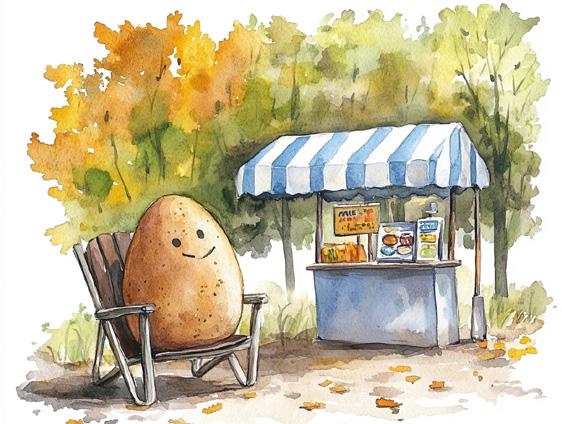


INTRO TO PASTELS
Doug Graybeal leads a four-part introduction to pastels course today and each Thursday through Oct. 24 from 1 to 3pm at The Art Base. Register at www.theartbase.org
POTATO WRAPPING
Want to be a part of the magic that pulls off this year’s Potato Day feast? Come help wrap potatoes and corn at the old Thompson House (301 Lewies Lane in Carbondale) from 4 to 6:30pm. Come by any time!
BRIDGES AT ANDERSON
Anderson Ranch in Snowmass Village presents artwork and poetry from Bridges High School students with an opening reception from 5:30 to 6:30pm. The show will remain on display through Oct. 25.
‘MOON OVER HUMBOLDT’
Journalist and recovering addict Jim Hight will perform dramatic readings, and discuss the themes of recovery and reconciliation, from his new novel, “Moon Over Humboldt,” at The Meeting Place (981 Cowen) at 5pm.
SIP AND PAINT
Amy Fulstone guides participants in painting their own zebras at El Dorado from 6 to 8pm. Tickets include a cocktail and all painting supplies and proceeds benefit WindWalkers Equine Assisted Learning and Therapy Center. Purchase yours at www.windwalkers.org/events
COMMUNITY CONVERSATIONS
Queer community leaders guide a Queer VOICES Community Conversation series where participants unpack a new topic each Thursday, today through Oct. 17, from 6 to 8pm in Basalt. All are invited to participate. Registration and more info at www.voicesrfv.org/community-conversations The location will be disclosed upon registration.
‘RECONNECT RETREAT’
Deva Shantay and Elena Brower guide a weekend-long “Reconnect Retreat” at True Nature. It starts tonight with an opening ceremony at 6pm and continues through the weekend. More info and registration at www.truenaturehealingarts.com
MUSIC AT HEATHER’S
Heather’s Savory Pies in Basalt presents Rodrigo Arreguín performing guitar at 6:30pm.
MOVIE NIGHT
Pregame the Potato Days weekend with some historical cinema! Catch “Red Stallion in the Rockies” — a 1949 Western filmed locally — screening at the Carbondale Library at 7pm. It’s free and open to all!
CRYSTAL THEATRE
The Crystal Theatre shows “Beetlejuice Beetlejuice” tonight at 7:30pm. “My Old Ass” screens Oct. 4, 5, 9 and 10 at 7:30pm and Sunday, Oct. 6 at 5pm.
DEREK FRANK
Steve’s Guitars welcomes Derek Frank’s “70s-inspired funk instrumental jams” with a five-piece group performing at 8pm. Tickets at www.stevesguitars.net
FRIDAY, OCTOBER 4
‘DARKNESS TO LIGHT’
The Buddy Program, in partnership with Riverbridge Regional Center, Aspen Youth Center, YouthZone and Aspen Family Connections, hosts a bilingual “Darkness to Light” training at the Third Street Center focused on the prevention of child sexual abuse on Oct. 17 from 5:30 to 8pm. Today is the deadline to RSVP at www.riverbridgerc.org/events
NATURE JOURNALING
Adults who wish to explore, observe and creatively document nature are invited to join a group of novice and experienced sketchbook artists every first Friday from 1 to 2:30pm at the Carbondale Library. Bring your own supplies. For more info, call 970-963-2889.
VOICES TINY STAGE
The VOICES ARTery Tiny Stage First Friday series continues with presentations by Lana Greengrass, Bineke Kieren and Travis Wilson at the Painted Pig in Carbondale from 5 to 6pm. More info at www.voicesrfv.org/the-artery
ART OPENING
The Carbondale Arts gallery hosts a First Friday opening for “Women (Im)Print” by Katie Browne and Bailey Haines and “Community Service Print Projects” by student artists of The Project Shop from 5 to 7pm.
BARN DANCE
Enjoy an early start to Potato Day with a community contra dance at the Carbondale Rec Center from 6 to 8pm followed by a funk concert by The Confluents from 9 until 11pm. All proceeds benefit the Carbondale Historical Society.
Jeff Rice and Katie Houchin,The Low End, perform at Heather’s in Basalt at 6:30pm.
GHOST WALK
The Glenwood Springs Historical Society hosts its 24th Annual Ghost Walk series every Friday and Saturday evening through Oct. 19 at the Linwood Cemetery. Actors portray real people from the past buried in the cemetery. Tours depart every 30 minutes, between 6:30 and 8:30pm. This year’s series will culminate in an indoors event at the Vaudeville Revue on Oct. 30 at 7pm. Tickets and more info at www.glenwoodhistory.com/ghost-walk
CONSENSUAL IMPROV
The Consensual Improv troupe performs at TACAW at 8pm. Tickets at www.tacaw.org
SATURDAY, OCTOBER 5
POTATO DAY
Carbondale’s longest-running festival continues with a Carbondale Rotary Club pancake breakfast at Chacos Park from 8:30 to 10:30am, the Ross Montessori Tater Trot race at 9am, a farmers’ market in Sopris Park all day, the parade down Main Street at 10:30am, a spike ball tournament from 11am to 2pm, the traditional community lunch from 11:15am ‘til 1:30pm, live music, a largest potato contest and more. For a full list of this weekend’s events, visit www.tinyurl. com/115PotatoDays
AVSC SPORTS SWAP
Aspen Valley Ski and Snowboard Club hosts a gear swap at Willits Town Center from 9am to 1pm. More info at www. teamavsc.org/sports-swap
THROWING CLAY
Molly Altman hosts “Fall Throwing Bootcamp” at the Carbondale Clay Center from 10am to noon. Register at www.carbondaleclay.org
BACKCOUNTRY SYMPOSIUM
Aspen Public Radio hosts the Valley’s inaugural Backcountry Symposium, which includes information about staying safe while recreating out of bounds, at TACAW from 11am to 5pm.
‘COEXISTENCE WORKS’
Suzanne Asha Stone and J. Dallas Gudgell of the International Wildlife Coexistence Network present

Roaring Fork Safe Passages (RFSP) brings Beth Pratt, responsible for helping raise $90 million to build the world’s largest wildlife crossing over a Los Angeles interstate, speaking at a fundraising event at the Gant in Aspen from 4:30 to 6:30pm on Friday, Oct. 4. RFSP is determined to reduce wildlife collisions in the Roaring Fork Valley and advocate for infrastructure to help protect people and wildlife. Tickets and more information can be found at www.roaringforksafepassages.org
Fork
“COEXISTENCE WORKS: Protecting livestock and wolves with nonlethal coexistence methods” at the Glenwood Springs Library at 6pm.
JOHN MICHEL
John Michel from the John Oates Band and Brother’s Keeper plays at Heather’s in Basalt at 6:30pm.
‘CROSSINGS’
Roaring Fork Safe Passages brings Ben Goldfarb, author of “Crossings: How Road Ecology Is Shaping The Future of Our Planet,” to Explore Booksellers in Aspen for a live interview conducted by local conservationist Tom Cardamone at 7pm.
‘BEYOND THE FANTASY’
Teton Gravity Research presents “Beyond the Fantasy,” its 29th annual ski and snowboard film, at TACAW at 7pm, preceded by a Tincup whiskey tasting in the lobby. The film shows again tomorrow at 3pm and 7pm. Tickets at www.tacaw.org
SUNDAY, OCTOBER 6
HELPING BEAVERS
Roaring Fork Outdoor Volunteers partners with Wilderness Workshop to improve the vitality of riparian habitat benefitting beavers near Rifle from 8:30am to 3:30pm. Find details at www.rfov.org
HEART LISTENING
Rev. Florence Caplow presents “Listening with the Heart” at the Two Rivers Unitarian Universalist service at the Third Street Center from 10am to noon.
YOUTH GYMKHANA
A youth rodeo (with popsicles) takes place at the Gus Darien Riding Arena on Country Road 100 from 10am to 2pm.
PASTURE PARTY
Close out Potato Days in style! Aspen Valley Land Trust’s Party in the Pasture at Coffman Ranch is from 11am to 2pm with food and drinks for purchase. Sweet Jessup & the Dirty Buckets will perform, as well as Aspen Santa Fe Ballet Folklorico.
HEATHER’S
Tim Veazy and Helen Highwater perform music at Heather’s in Basalt at 6:30pm.
MONDAY, OCTOBER 7
GRIEF WALK
Cath Adams guides a Grief Walking Group for people navigating the path of loss every Monday at 9am, departing from the Glenwood Springs Recreation Center. More info and registration at www.tinyurl.com/GriefWalkGWS
THEM APPLES
Young children and their caregivers are invited to learn about apple seeds and cider at the Glenwood Springs Library at 10am.
SHOMAN AND COOLE
Steve’s Guitars welcomes John Showman and Chris Coole of the Lonesome Ace String Band for a show at 8pm. Tickets at www.stevesguitars.net
TUESDAY, OCTOBER 8
LIBRARIES CLOSED
All Garfield County libraries will be closed today for staff training.
PROTESTING GENOCIDE
Ceasefire Now RFV gathers protestors at Centennial Park in Glenwood Springs from 6 to 8pm, “to mark one year of Israel’s genocide in Gaza, and now invasion of Lebanon.” After holding banners and signs facing Grand Avenue, there will be a community grief circle from 7 to 8pm. For more information, contact ceasefirenowrfv@gmail.com or visit @ ceasefirenowrfv on Instagram.
GLENWOOD CONCERT
The Glenwood Springs Community Concerts Association (GSCCA) brings pianist Jared Freiburg and the Vagabonds to Glenwood Springs High School’s theater at 7pm. GSCCA season tickets and more info at www.gsconcertassn.org
WEDNESDAY, OCTOBER 9
FLOWERSCAPES
Using oils on canvas, Tania Dibbs guides participants in responding to the variety of shapes, colors, lines and textures of flowers to create beautiful images. It takes place at The Art Base from 6 to 8pm today and Wednesday, Oct. 16. Register at www.theartbase.org
MARY LOUISE KELLY
Aspen Words brings novelist and the host of NPR’s “All Things Considered,” Mary Louise Kelly, to the TACAW stage for a conversation moderated by Aspen Public Radio Executive Director Breeze Richardson at 6pm. Register for this free event at www.tinyurl.com/ MaryLouiseTACAW
R 1 6 , 2 0 2 4
6:30PM - 8 PM
Enjoy some delicious food then learn about the Carbondale Latino Advisory Board
This board, created through Resolution No. 8, Series 2023, was designed to amplify the voices of our Latino community, enhance cultural understanding, and guide the Town on issues that matter most to Latino residents. Whether you're interested in learning more, getting involved, or volunteering for the board, we would love to have your participation.
AT THIRD STREET CENTER, CALAWAY ROOM 520 S 3rd Street Carbondale, CO 81623

JOHN STROUD Sopris Sun Correspondent
Another chapter was added to a storybook season for the Basalt High School boys golf team on Monday, Sept. 30.
The Longhorns, including a trio of Roaring Fork High School golfers, took second place as a team at the 3A Regionals, held at the Snowmass Club, to qualify for the 3A State Championships, slated for Oct. 7-8 at Walking Stick Golf Course in Pueblo.
Aspen junior Houston Benvenuto won the regional championship with a round of 69 for 18 holes, leading the Skiers to the team title with a combined low score of 229.
Basalt was four strokes back at 233, led by senior Jackson Stewart, who carded a 76 to finish second, and sophomore Hudson Arnold, who tied for third with Aspen senior Ryan Rigney at 77.
Basalt freshman Parker Strelecki finished tied for 10th (80) to round out the Longhorns’ scoring. Sophomore Griffin Didier will join the team at state, despite a rough day on the course Monday, finishing 26th with a round of 88.
“Qualifying as a full team for the 2024 Colorado High School State Championships is a huge accomplishment for these young men, individually and collectively,” head coach Travis Stewart said.
“This will cap off a highly successful
season highlighted by the strong senior leadership and play of Jackson Stewart, as well as the great play of the young core and future of this team,” he said, referring to Didier, Arnold and Strelecki.
Soccer downs Basalt for hoco win
The Roaring Fork boys soccer team got homecoming week rolling with a 3-1 win over rival Basalt at Rams Field on Tuesday, Oct. 1.
With a large and loud student section cheering them on, the score was tied 1-1 near the end of the first half after junior Delano Crooks scored on an assist from sophomore Cal Stone, and then Basalt answered with a goal of their own.
Rams sophomore Cristian Turcios got the go-ahead goal off a high, soft cross pass to the left side from senior Fernando Rodrigues-Candela to make it 2-1.
Soon into the second half, Stone collected a tight pass across the box from junior Salbador Vasquez and booted it in from the right side to put the Rams up by what would end up the final score.
Head coach Nick Forbes said he was most impressed with his team’s mental play, given the distractions of homecoming week and the fact that the Longhorns were seeking revenge after being shut out by the Rams 7-0 on Sept. 5 at Basalt.


“I’m just really proud of these boys for digging deep and realizing they had to rise to the occasion after Basalt came back and tied it,” Forbes said. “They did a good job of overcoming those things that can be kind of hidden traps in high school, like homecoming and rivalry games.”
The win came on the heels of a 1-1 tie to Summit at home on Saturday, Sept. 28 (goal by Rodrigues-Candela), and a 4-0 win at Grand Junction High that Friday (2 goals by senior Phillipe Huang, and one each from Crooks and Stone).
The Rams took their 5-2-1 overall record and 3-0 3A Western Slope League mark on the road to Delta on Wednesday (results not available by press time).
The Roaring Fork girls volleyball team notched one in the win column at home on Tuesday, Sept. 24, prevailing 3-2 over 3A league opponent Olathe (25-19, 19-25, 25-18, 23-25, 15-8).
Junior Nikki Tardif recorded 18 kills and five aces from the service line on the night. Junior Yakelin Nunez Hernandez had 14 kills, and senior Carley Crownhart had 31 assists.
In other action this past week, the Rams lost 3-1 (18-25, 25-22, 21-25, 20-25) at Aspen on Sept. 26, and dropped a 3-0 decision at Gunnison (22-25, 20-25, 17-25)
continued on page 15


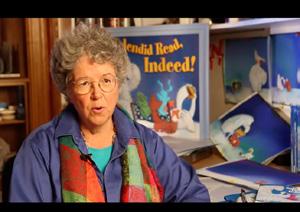


















on Sept. 28.
The Rams are now 3-9 overall and 1-4 in league headed into their homecoming game this Thursday, Oct. 3 against Grand Valley (varsity game time 6:30pm at the RFHS Gym).
*Note: The Roaring Fork football team, which was idle this past week, hosts Grand Valley for the homecoming football game at 7pm Friday at Rams Field.
The combined Basalt-Roaring Fork cross country team was at the Moffat County Invitational on Saturday, Sept. 28, where junior Towler Scott won the boys title with an impressive time of 16 minutes, 15.3 seconds.
The girls took second place as a team with 41 points to Steamboat Springs’ 31. Finishing in the top 20 for the Lady Longhorns were senior Izzy Moon, fifth (21:11.6); junior Caroline Cole, sixth (21:31.1); junior Addison Raymond, 11th (22:31.4); and sophomore Sadie Silcox, 16th (23:03.8).
The combined Basalt girls softball team picked up a 22-12 win at home against Battle Mountain on Sept. 23, collecting 11 runs through the first two innings and eight in the fifth.
The Longhorns then lost both games of a double-header at Delta on Sept. 24, 22-2 and 19-4.
Four Roaring Fork student-athletes play on the team: Jenna and Sydney Ostberg, Zoe Kincaid and Hana Irigoyen Esquivel.




Join our team! The Art Base is a non-profit art center in Basalt, CO, which fosters creative expression in the visual arts for all ages and abilities, through education, exhibitions, and providing opportunities to artists and artisans.
The Community Partner Programs Coordinator will be a friendly and community – centric person who is committed to the success of inclusive educational programming at the Art Base. Under the direction of the Education Programs Manager, the Community Partner Programs Coordinator will be responsible for co-creating and coordinating innovative programming with organizations serving underrepresented groups, aiming to expand art classes and opportunities, making art accessible to all. The Community Partner Programs Coordinator will report to the Education Programs Manager. Hourly salary $26 - $28 with commensurate experience
Sept. 27, placing several individual runners in the top 20 of the 3,000-meter race. They were: Ayla Klein, third (13 minutes, 35.9 seconds); Tillie Vickers, fifth (13:41.3); Maggie Cole, ninth (14:19.1); Kiray Greengrass, 12th (14:34.4); Rae Vickers, 19th (14:53.5); Camellia

ANNALISE GRUETER
Sopris Sun Correspondent
What started out as a creative solution to mentorship waitlists has become a staple of 10 Roaring Fork Valley schools. The Buddy Program’s Leadership through Exploration, Action and Discov ery (LEAD) courses began in 2013, offering additional support and mentorship to local teen agers. There is always a need for more adult buddies to fill one-toone matches, but by offering school-based courses at Carbon dale Middle School and Roaring Fork High School beginning in 2013, the Buddy Program laid out another avenue for such mentor ship. Today, LEAD serves almost 200 young people, from Aspen to Rifle, each year.
From the beginning, LEAD has taught communication, lead ership techniques and other life skills. This is more than just outdoor excursions, because the processes of planning and nego tiating are facilitated experiences too. LEAD high school programs include a backpacking trip in September, a hut trip in early April and an end-of-year trip in late May or early June. Middle school programs meet only once each month, but include a simi lar curriculum: two multi-day backcountry excursions, and single-day field trips.




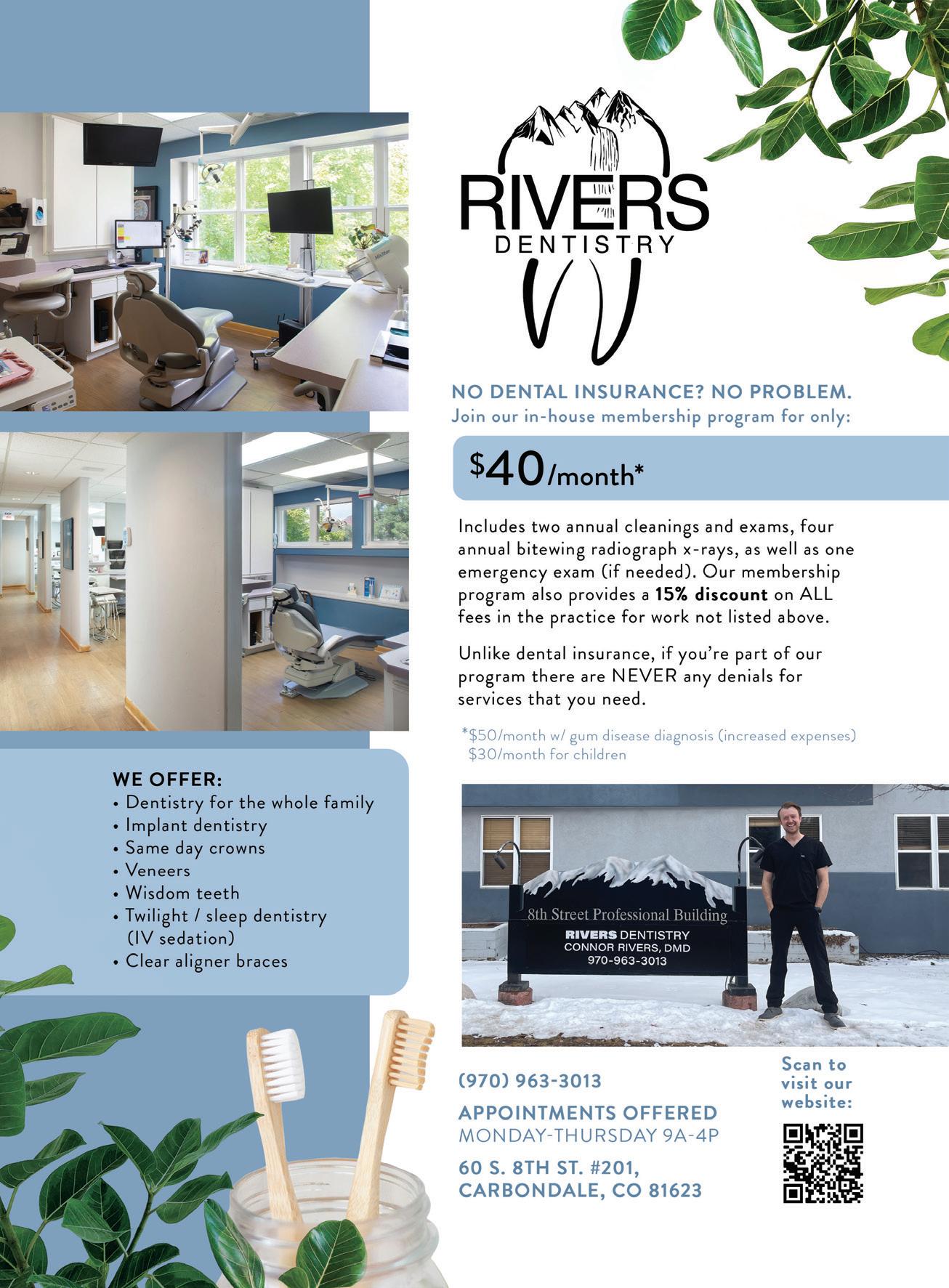





Thanks You To Our Sponsors: Alpine bank, Amore Realty, ANB Bank, Aspen Roofing Contractors, Carbondale Center LLC, Crystal River Ranch, Distinguished Boards & Beams, Coldwell Banker Mason and Morse, Garfield County Libraries, Mountain Waste & Recycling, Roaring Forge, Roaring Fork Rentals, Seven Star, Rebekah Lodge no.91, Sunsense Solar, Omni Shading Solutions
guiding since he was a teenager. He attended a National Outdoor Leadership School (NOLS) instructor course at age 18 in 1970, taught by NOLS founder Paul Petzoldt, and started working for the organization shortly thereafter. “I’ve always enjoyed sharing experiences. I’ve always felt called to share,” Dawson continued. “That led to all the guidebooks and guiding, leading folks in the backcountry.”
He spent the next 14 years guiding — in between countless personal mountaineering pursuits, including many first ascents and descents — before publishing his first guidebook, “Colorado High Routes,” in 1986.
Within the nearly four decades since, Dawson continued these pursuits. A self-described introvert, he finds writing and knowledge-sharing about outdoor activities to be his most comfortable and favorite modes of spending time with those outside his inner circle. Asked whether demographics differ between speaking events and guidebooks, Dawson responded, “There isn’t a specific target group or medium. The more opportunities people have to learn and gain information, the better.”
“It’s tempting to generalize demographics, but it’s actually important not to do that. Risk tolerance and experience conversations should be based around each individual, not descriptions that may or may not apply to them,” Dawson stated. He also emphasized the importance of group- and self-awareness. “There’s a certain amount of caution involved in self-exploration as well as outdoor exploration. These kinds of sports require a high degree of self-assessment, not just external risk assessment.”
Dawson recommends that everyone spending time in the backcountry also spends time thinking about how they make decisions. “How much risk do you think you’re undergoing when you choose to ski a slope or climb something, versus the actual risk you’re undertaking?” he prompted.
The points Dawson emphasized are exactly what McBride hopes to convey at the symposium: Reinforcing connection and communication in the outdoors and within the recreating community. Before and during a backcountry excursion, Dawson said, “It should come down to respect, communication and the concept of the veto. If someone becomes uncomfortable, does the group have a plan of what to do?” The answer: Know before you go.

the home maintaining a maximum resale price at 70% of the home’s value at sale, with a 3% appreciation cap.
The beauty of a buy-down program is that it adds units to the existing deed-restricted affordable housing stock without new construction, WMRHC board co-chair and Carbondale Trustee Colin Laird said.
“We knew there was a lot of demand for (deed-restricted) housing, but we just don’t have enough affordable housing units to meet that demand,” Laird said. “With the dynamics of how expensive it is to build new units, this is a way of creating deed-restricted units without new development.”
So far, the homes that are under contract or purchased through the program, and situated between New Castle and Carbondale, range in purchase price from $548,000 to $1.1 million.
The current construction price for just one affordable housing unit in Pitkin County is approximately $1 million, and would likely take years to complete, Long said.
The program models the successful Good Deeds program in neighboring Eagle County, where 76 new deed-restricted units have been added to the county’s affordable housing stock in three years.
By the end of October, WMRHC expects to have five new deed-restricted units added to the affordable housing mix at a cost of approximately $1.2 million.
But it will need additional funding to accomplish that goal, and not just from local governments, Long and Laird both acknowledged.
In addition to reaching out to local governments and brainstorming a possible dedicated funding source in the future, continuation of the program will likely hinge on obtaining support from the private sector, including philanthropic entities, they said.
“We would love to have a match for what these local governments are putting in,” Long said.
She said Pitkin County officials have also indicated that the county would be willing to continue to support the program through its proposed ballot initiative in the Nov. 5 election that seeks a dedicated property tax for affordable housing needs, should it pass.
But one hindrance to putting local dedicated tax dollars into the Good Deeds program is that it would most likely just benefit new deed-restricted units in that jurisdiction, where the WMRHC program includes multiple jurisdictions spread across three counties.
Long said City of Glenwood Springs officials are also in discussion about using a portion of that city’s dedicated affordable housing fund to offset some of the WMRHC’s 30% contribution to buy-downs within city limits.
Laird said the WMRHC board has had discussions about exploring a regional real estate transfer fee, instead of a tax. But those conversations are preliminary and such a funding mechanism likely a ways off from becoming a reality, he said.
For now, WMRHC is actively seeking individual contributions and additional funding sources to continue the program. Tax-deductible donations can be made by visiting wmrhousing.org
Any prospective homebuyers who would be interested in participating in the program can find more information at wmrhousing.org/gooddeeds
Saturday, October 12 10:00 a.m. – 2:00 p.m.

Permítanos encontrar los recursos que necesita.
Carbondale Fire District invites you to our Annual Community Open House. It will be a great time with something for the entire family. Enjoy fire truck rides, face painting, meet Sparky the Fire Dog, have your children participate in the Junior Firefighter Bucket Brigade Challenge, station tours, fire extinguisher training, vehicle fire response demos, free giveaways for the whole family, and MORE! Join us for lunch and get to know your friends at Carbondale Fire.
• Fire Truck Rides
• Hamburgers and Hot Dogs
• Face Painting
• Meet Sparky the Fire Dog
• Free merch

• Check Out Fire Trucks and Ambulances with Your Local Heroes
• See the Classic Air Helicopter
• Fire Extinguisher Training
• Junior Firefighter Bucket Brigade Challege (kids – get ready to compete!)
• Home Fire and Life Safety Demos
• Vehicle Fire Demos
• Sign up for Emergency Alerts
CARBONDALE &



Have you heard of project 2025? (No, that’s not the name of Aspen’s new airport plan.) Remember Trump’s first term? Specifically, when he showed up at the White House with his troupe of misfit carnies, asking where the coffee maker was … government desks and departments left empty for months — even years — as the narcissist took more interest in his Twitter POTUS sign-on than anything actually presidential. Well, this time his minions are busy recruiting newly minted bureaucrats who want to run away and join the circus. The government workers who would normally remain in their position throughout different administrations to ensure expertise and consistency, will all be replaced with blindly loyal, ham-fisted clowns. Project 2025 is an open call for positions with organizations like NOAA or NASA: No experience necessary! Because Trump wants to control time and space by using a sharpie on the constitution. I use a sharpie for my job. As a greeter at the Aspen airport, I stand alongside the fancy hotel employees with their ipads displaying the name of the passenger for pickup, while holding a clipboard with the name (usually an alias) written in sharpie on old-school white copy paper. Hey, it works, and part of the charm of flying into Aspen is that it looks like it has my whole life.

Ps & Qs
Jeannie Perry
One of the best things about the town where I was born was the way it remained true to itself through all the boom-and-bust storms that blew through. From silver prospectors to ranchers, bikers to cokehead skiers, Aspen welcomed everyone who found their way to this little picturesque town in the Rocky Mountains. And in the beginning of the end, it was still a great place to go to get away from the celebrity looky-loos. Stars could pull up a bar stool and have an anonymously good time like the rest of us. Aspen was a great equalizer, just like the TSA today.
Boy, those gals do not care where you’re from or how much you brought to the party, they will pat you down like a repeat offender in county jail. Over the years, I’ve greeted rock stars to generals, Hollywood royalty to Middle Eastern heirs, and they all seem perfectly content with our small-town airport vibe. Of course, my greets fly commercial. I can’t speak for the other half (83%??) flying private down the road at ABO [Aspen Base Operation].
These days private jets flock to Sardy Field like pigeons on a croissant. I get it; the rich can’t help but wealth-appropriate the customs and rituals of Roaring Fork locals. After all, they come and look around at the rest of us having a good time, it makes sense they want some of that … Unfortunately, they end up running the fun right out of town by upping the cost of everything, and that’s how a town loses its luster.
Because Trump wants to control time and space by using a sharpie on the constitution.
But don’t feel bad for the billionaires. They have it pretty good in this country where the rich get richer, while the poor get taxed. Using taxpayer money for a new runway, sure, but adjusting to accommodate larger private jets leaves a taste in the mouth of petit fours. And the bigger issue with increasing private plane traffic is the lack of a workforce. Who is going to land and service all these VIPs? Maybe Pitkin County can adopt a Willy Wonka system where they insert golden tickets into protein bars and if you’re the lucky finder, then you get to report to work at 5am in the dark winter mornings.
“Wake up and smell the coffee, Mrs. Bueller. It’s a fool’s paradise. He is just leading you down the primrose path.” - Edward R. Rooney
Speaking of fools, I would really like for the media to stop normalizing a felon running for office. Trump has done nothing but lie, cheat and steal to get his paradise, built on the backs of all the working-class Joes he swindled. He has no qualifications and no civil motivations on his wanna-be-a-billionaire ticket. He will be the first president to be convicted of felony charges, the first one to be openly canceling votes and, I’m sure, the first to land Air Force One on our tax-funded tarmac.
Reject Project 2025.
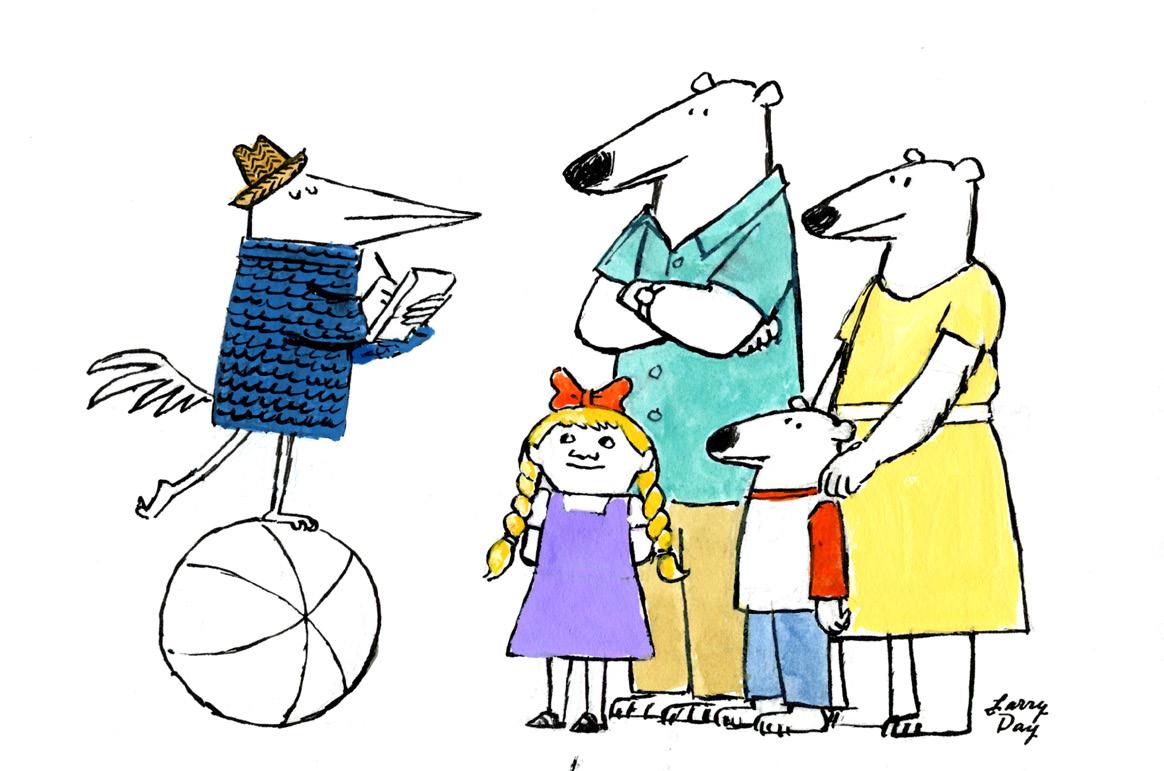
In “A Man for All Seasons,” Sir Thomas More dismisses his daughter’s pleas to save his own life by compromising his ideals and acquiescing to Henry VIII. He says, “When a man takes an oath, Meg, he’s holding his own self in his own hands. Like water. And if he opens his fingers then, he needn’t hope to find himself again.”

By A.O. Forbes
I am a high school geography teacher and believe geography can reveal our character using the “landscapes” we create and live within as a mirror of self-evident truths about who we are. Are these landscapes just? Are they sustainable? In my classes, there are often conversations about “being real,” finding and then holding onto your authentic self — trying to live with your actions aligned with your values and not sell out, to make life better for all! We spend time trying to identify and possibly defuse those situations that can bring unbearable pressure on us to “open our fingers” and lose our own souls.
I first met Adam for a cup of coffee at the Creamery. I had been told that he was “real,” soulful, and might speak to my class about his experiences in the war in Iraq; could speak to holding onto your humanity under unbearable pressure. The following week he came to my class. He sat down, introduced himself, and asked others to say their name — honoring everyone in the room with a huge smile and a thank you.
He began to tell his story. He smiled as he described how his grandfather, a WWII hero, used to tap rhythms on his chest as he sang the Marine anthem. Adam spoke with his hands, shirtsleeves rolled up, revealing tattoos that moved on the curves of his muscular arms. Minutes later, Adam’s story seamlessly traveled to Iraq where he was part of the invasion, months after 9/11. He had enlisted the day after 9/11 but had to wait for his 18th birthday to join. He smiled as he recounted his excitement on the way to Iraq, daily practice runs to the border only to turn around and go back to the base. Then one day they didn’t turn back and they invaded Iraq. So many people, tanks, helicopters, all moving in unison, the relative ease with which they moved through Iraq, the looting of an Iraqi cigarette factory and handing out cigarettes to all the people — so welcoming and exhilarated with expectations of justice, electricity, and water.
The colonel hugged everybody each day before they went out on patrol, to make sure they knew that he loved us.
And then his story turned on a dime. A young child walks towards them carrying a covered basket: “Ameriki, Ameriki!” Is it a loaf of bread or a bomb? Adam pauses, and smiles turn to tears in our class. Adam describes leading a patrol, they are protecting villagers from the Taliban; he speaks with his arms carefully on the table, describing the positions of the men. A perfect operation around a house they are protecting from Taliban recruiters. A shadow glides across the rooftop — Adam’s hands mimic the muffled staccato noise of his AR15 being fired, two shots.
The shadow falls from the roof: a father shielding his daughter from the Taliban falls from the roof. Adam describes the out-of-body experience as he watches himself take the wounded girl to the hospital and then buries the father by the river. Adam’s attention to detail is impeccable, and the memories vivid. Adam is with us but elsewhere, we hold our breath until he finds his way back to his story. The first life he has taken.
Adam was wounded his second year when his Humvee was blown up by an IED on a drive bringing a cross for Christmas services. Although seriously hurt, he refused to leave his men until his commanding colonel flew in and forced him to get on the medevac helicopter. He described him as a big hugger. We sheepishly asked what that meant. He smiles and says, “The colonel hugged everybody each day before they went out on patrol, to make sure they knew that he loved us.”
Class ended and 15 students thanked him and then waited, and I wondered for what. I told them to hurry to the next class. A student who I knew was contemplating joining the military came up and stood awkwardly in front of Adam, saying, “Can I have a hug?” Every student gently followed, lining up to get a hug from Adam.
Adam didn’t talk about right and wrong, misinformation, politics, or human rights. He described his moral ceiling. When asked, “How can you take a life?” Adam replied that it began with clarity — love for your men and country — which then got lost through the insidious ease with which your moral ceiling rises, allowing you to do things you never imagined you could do.
Why were the students so moved? I’m not entirely sure, but I think it has to do with Adam’s allegiance to telling the truth, to bearing witness to how difficult it is to be human. To be trusted to hold these “truths” with a tender grip is the key to honoring each other’s humanity, and is integral to seeing ourselves in each other as we try to hold tight to the sacred nature of our being. In this exchange, it was an honor and an inspiration to watch my students hold Adam’s truth, his humanity, securely in their hands.
Aspen
Mi Chola
Aspen Valley Hospital
Snowmass Market
The Aspen Store
Box on Hyman Avenue
Pitkin County Library
BASALT
Basalt Quick Lube
Basalt Regional Library
The Basalt Store
Alpine Bank Basalt
Timbos
7/11
Jalisco Grill
Big O Tires
CC Cafe
WILLITS/EL JEBEL
El Jebel Mobile Offices
Midvalley Surgery Center
El Jebel Laundromat
Eagle County Courts
City Market
Scottie’s
El Korita
Box on San Miguel
Casa Tequilas
TAC Fitness
ANB Bank
CARBONDALE
Catherine Store Garcia’s City Market
Alpine Bank Box at La Perla
Box at “Main St.”
Recreation Center
Carbondale Library
CMC
7/11
Jalisco Grill
Mi Lindo Nayarit La Fogata
Gloria’s Boutique
GLENWOOD SPRINGS
7/11 West Glenwood
Office Hospital Valley View Recreation Center
Family Health Welcome Center
GWS Library
Sal Mex
La Michoacana
Coin Laundromat
Tony’s Market/Bakery Tequila’s
Frida’s El Yaqui
Kum & Go
Comfort Dental
Impuestos Seguros
NEW CASTLE
Tapatio’s Post Office
Taquerina Elias
New Castle Library City Market
SILT
Silt Library
Silt Laundromat
Kum & Go (Main St.)
Silt Roundabout La Placita 2
RIFLE
Tapatio’s Kum & Go
Taugenbaugh
Jalisco Grill
Box at City Hall
Rifle Library
Box at E 12 St.
El Patron
El Rincon
Spyderwash
Moma’s
Remington Square
Mercado San Jose
Carniceria San Jose
Nachos Mexican Dining
Paleteria la Korita
ProMex Bakery
Tutty Frutti
DANIEL TORRES Y BIANCA GODINA
Sol del Valle
Buddy Program es una organización sin fines de lucro desde 1973 en Aspen, donde han dirigido sus programas y actividades con alcance en comunidades hispanas, indígenas y afroamericanas, con extensión regional llegando hasta Glenwood Springs. “Nuestro compromiso es con la justicia social, la diversidad y la inclusión. Movimiento más allá de la tolerancia y hacia la inclusión activa, la afirmación y la celebración de nuestras diferencias” — esto según su página oficial (www. buddyprogram.org). Buddy Program cuenta con cuatro programas de mentorías para adolescentes y niños, con más de 500 participantes y voluntarios y un promedio de 30 jóvenes en lista de espera durante todo el año. Uno de los programas es Buddy Pairs en las escuelas, el cual reúne a un mentor adulto y a un joven, conocidos como little buddy, una vez a la semana durante el año escolar, dentro de las instalaciones de su escuela, normalmente dentro del horario de almuerzo. Los Little Buddies son seleccionados por el consejo estudiantil de su escuela, invitados por un amigo o familiar de algún participante, para posteriormente ser asignados a un Mentor Adulto, donde “10 de las 83 parejas actuales que son Buddy Pairs hablan español. Esto no significa que siempre hablen en español entre ellos, pero estos pares son bilingües, biculturales”, explicó Jennifer Balmes, gerente de mercadeo y comunicaciones de Buddy Program, en entrevista para Sol del Valle. Dentro de este programa, los niños, las familias y los mentores reciben apoyo y preparación continua del equipo de Buddy Program durante toda su relación. Para esto se proporcionan, de manera gratuita, materiales para realizar actividades artísticas, manualidades y juegos al aire libre. Además del apoyo psicoemocional que se pretende realizar a través de estas actividades. Al respecto comenta Balmes, “El mentor se hace parte de la familia y esa familia se involucra en la comunidad por medio de los mentores. Hemos tenido parejas que se han mantenido por más de 10 años, donde se involucran unos con otros en sus vidas de manera positiva y toman las mejores decisiones. Les da la experiencia de hacer cosas nuevas en este nuevo rol de familia.”
El programa Comunidad, se centra en los jóvenes de entre 6 y 18 años, invitados por maestros, consejeros, padres, agencias comunitarias, socios o por ellos mismos. Los Buddy Pairs de la
comunidad se reúnen individualmente tres o cuatro veces al mes para realizar actividades que disfrutan y participar en actividades gratuitas de Buddy Pairs y oportunidades especiales organizadas por el personal del Buddy Program. “Aproximadamente el 60% de los jóvenes involucrados en el programa provienen de hogares de habla hispana”, aclara Balmes. Además, el Buddy Program se asocia con empresas locales para ofrecer productos y descuentos a nuestros Buddy Pairs cuando salen juntos. “Necesitamos más hispanohablantes ya que tenemos una lista de espera de jóvenes en cada comunidad. La importancia de los mentores hispanohablantes es de suma importancia”, concluye Balmes, en su entrevista para Sol del Valle.
Sylvia Castoren, coordinadora del programa de mentoría y actual Big Buddy o mentora adulta comparte, “Yo siempre habia estado del otro lado de la situación donde me tocaba buscarles buddies a los jóvenes y a sido complicado en ocasiones ya que muchas veces son bilingües y latinos”. Castoren continua, “Sus respuestas a veces los llevan a la conclusión de que les gustaría que su Buddy adulto sepa hablar español, que pudiera compartir también su cultura con ellos”.
Castoren invita a los adultos en la comunidad de Roaring Fork a formar parte de la misión de Buddy Program de apoyar a los jóvenes al introducirlos a una diversión sana y libre de ningún costo.
“Me gusta la forma en la cual yo puedo soltarme y conectar con mi ‘Little Buddy’, Itzel. Regrese a mi juventud, tenía mucho que no me subía a un rollercoaster [montaña rusa] y fue muy divertido”, comentó Castoren.
Castoren explica que las barreras que a veces existen como el dinero, la falta de tiempo o el necesitar tener algún “expertise” o habilidad específica, Buddy Program se encarga de romper esas barreras. El programa ofrece actividades libres de ningún costo, solo se necesitan de dos a cuatro horas por mes y por último no se necesita más que querer convivir con los jóvenes y aprender a la par de ellos.
Full edition is available every Friday afternoon on newstands and at businesses from Rifle to Aspen
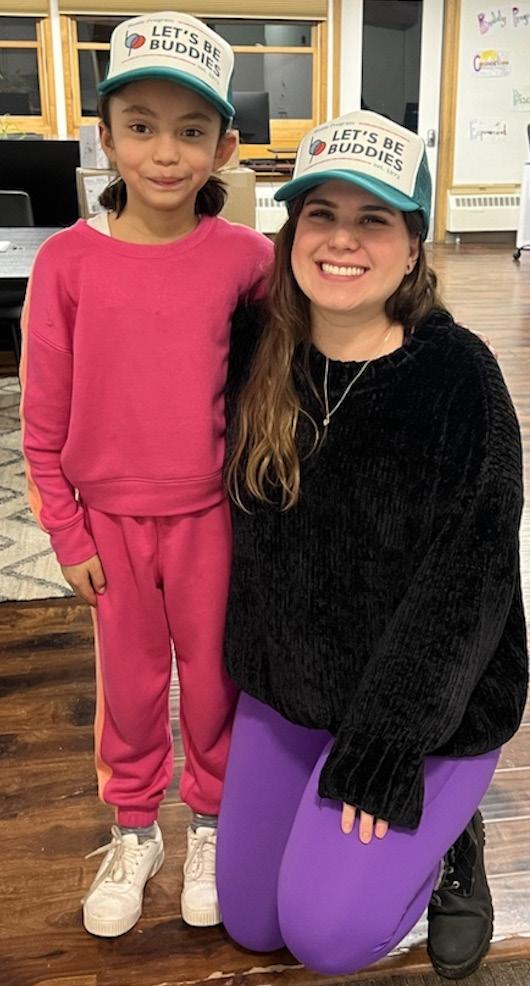

Para más información, visite www. buddyprogram.org o puede encontrarlos en redes sociales como “Buddy Program”.


Share your works in progress with readers by emailing illustrations, creative writings and poetry to fiction@soprissun.com
By Larry Day
We peel the cloak of aluminum To reveal our roasted potateeyum
Comparte tus proyectos creativos aún en proceso con nuestros lectores. Puedes enviarnos un correo electrónico con tus ilustraciones, creaciones literarias y poesía a fiction@soprissun.com
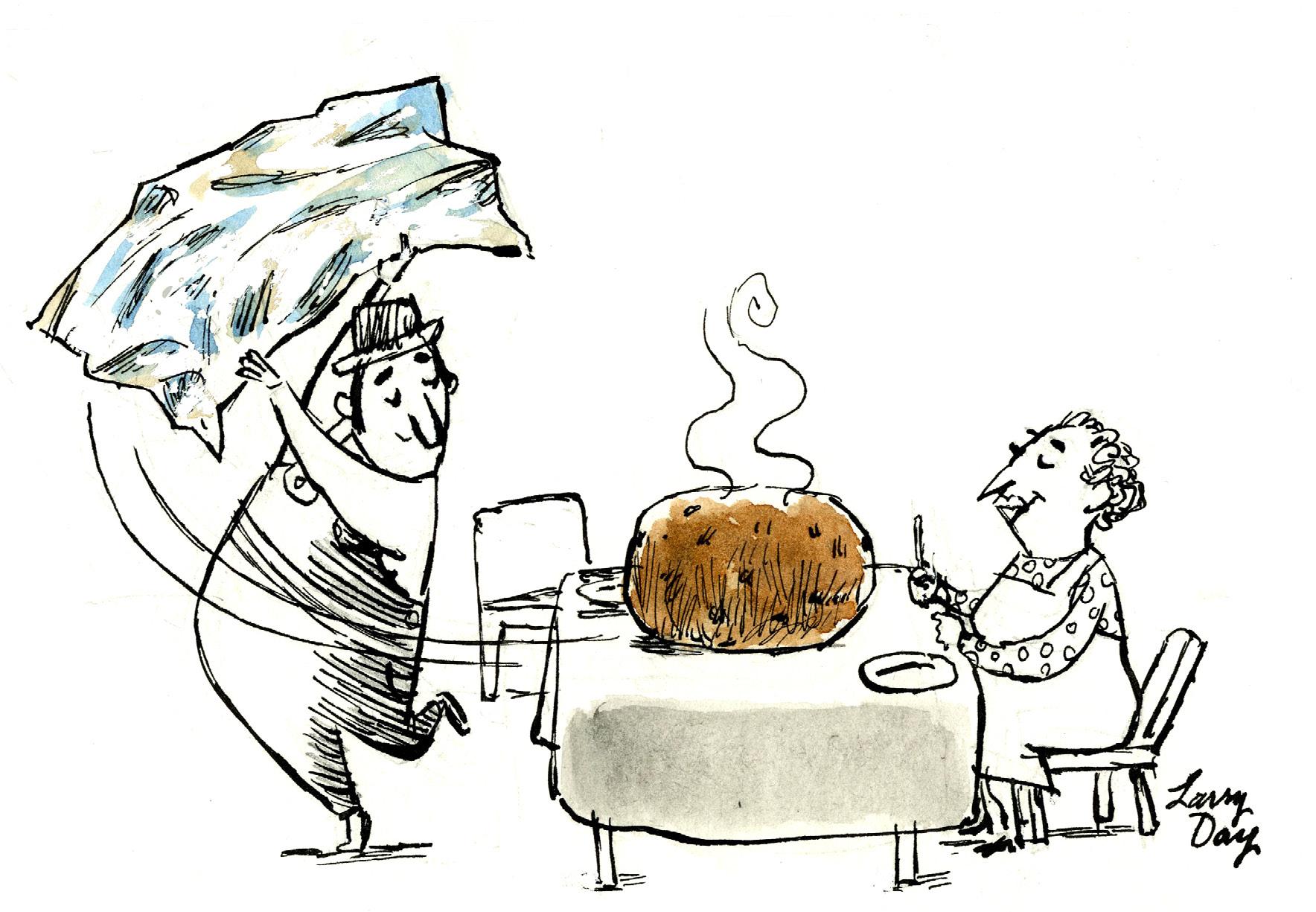

Sábado, 12 de octubre de 2024
2 - 5 PM
Biblioteca de Glenwood Springs
¡GRATIS para
Únase a un día de:
Divertidas Actividades de Arte
Cuentos con Asombrosas Autoras/Ilustradoras
Mural y Pinta Caritas
Rosybelle, el Autobús de Arte
Zoológico de Instrumentos
¡Smokey el Oso y más!





















Photo and text by Jane Bachrach
The trees at RVR are showing us fall has arrived and is in full swing. Yet, the weather disagrees, giving us more summer vibes with temperatures in the mid-80s!




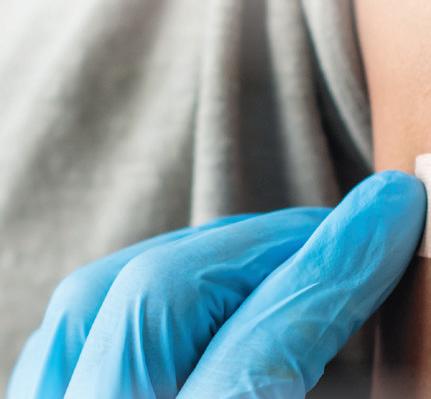





Garfield County Public Health 2014 Blake Avenue, Glenwood Springs Wednesdays Oct. 9, 16, 23, 30 | Nov. 6, 13

Garfield County Public Health, 195 W. 14th, Rifle Thursdays Oct. 10, 17, 24, 31 | Nov. 7, 14

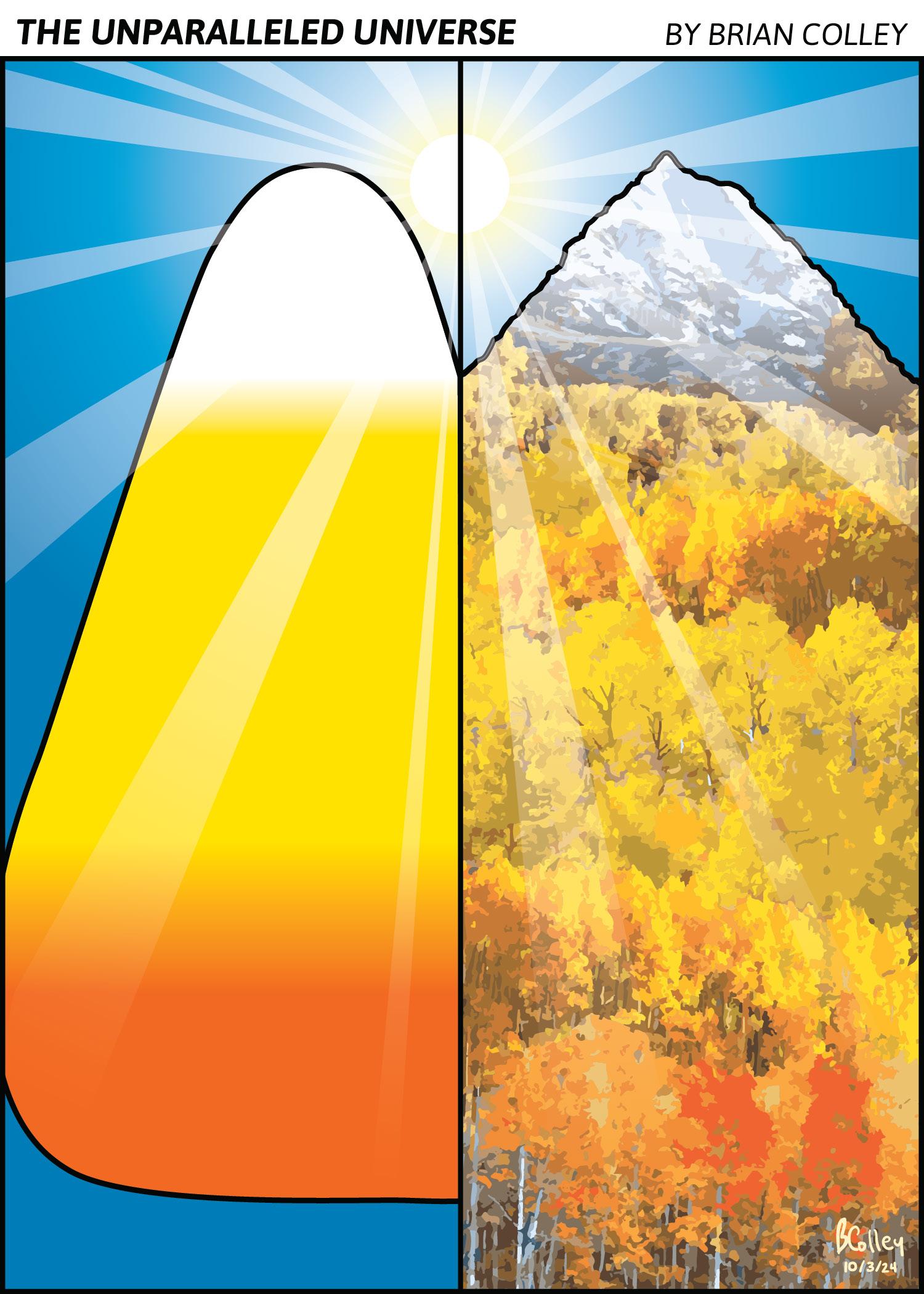
against a bill to ensure that contraception and abortion remain legal in Colorado (HB22-1279) and against a bill to protect Colorado doctors from criminal prosecution if they provide reproductive healthcare to people from other states.
He voted against protecting the rights of mobile home park residents (HB241294), against allowing graduates to wear a sash of cultural significance at their graduation ceremony (HB24-1323), against aid to homeless higher education students (HB24-1403) and the list goes on and on.
To top it off, Will voted in favor of formally thanking those who participated in the January 6 attack on our country.
There’s no better way to evaluate a candidate than reviewing their past actions and votes. Will would prefer that voters “not get into” his voting record. I
Caitlin Carey has a strong record on New Castle Town Council of listening and responding to her constituents, including fighting for affordable housing for families and essential workers, supporting
from page 11
Regardless of what and how you choose to grow, all gardeners agree that having fun and enjoying the process is
“You have to start somewhere and see how it goes,” said Collins. “Everything has its season and cycle, and it’s very interesting to sit back, watch and learn the pattern. I say, just plant and connect!”
Curious about Colorado gardening? Check out Colorado Mountain College’s upcoming community classes: Vegetable Gardening 101 and Seed Saving. Connect with The Flower and The Bean on Instagram @theflowerandthebean.farm and on Oct. 5 at
local law enforcement and taking action to preserve Garfield County’s water rights. The choice is clear. Will is not in tune with Garfield County residents. Caitlin Carey is.
Debbie Bruell Carbondale
Eighteen and voting
In my freshman year of high school one of the first things I was taught was how to examine a website for factual inaccuracies and bias. I learned to read between the lines and analyze potential biases to uncover the truth behind the content. However, this is often challenging. Confirmation bias and the pandering of certain media outlets to specific viewpoints have become alarmingly prevalent and hard to escape. This is why libraries and unrestricted access to books are more important than ever.
I am deeply concerned about the Garfield County commissioners’ decision to take control of selecting library trustees.
continued on page 23

a grandfather of 21, there’s all kinds of views. Don’t ever think you’re always right. Anything else you’d like to add?
My opponent Stephen Arauza is a different guy than Mike Samson. Educate yourself about where he’s coming from because his vision and the way he wants to do things in many ways will be different from mine. Uneducated, uninformed voters
*According to the Pew Research Center, the unauthorized immigrant population in the United States grew to 11 million in 2022.

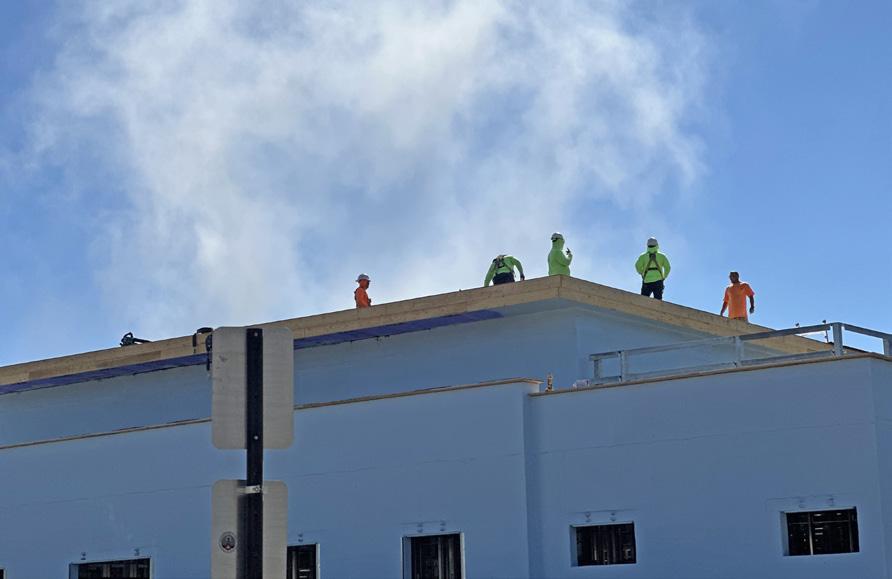
Pitkin County Open Space and Trails ranger Megan Ballard locked the gate to Filoha Meadows Nature Preserve on Sept. 30, the last day of the season. Roaring Fork Conservancy invited a group to tour the 185-acre property, located across the river from Penny Hot Springs, to learn its history while enjoying the fall colors. This thermal wetland supports rare plant species, a firefly population and provides winter habitat for elk and bighorn sheep. Its name is derived from the Ethiopian word for “hot water.” Daytime pedestrian access via Dorais Way will resume July 1, 2025.
Photos by Raleigh Burleigh




Previously, the library board itself selected new members, but now the Board of County Commissioners (BOCC) has made it so they are the authority in choosing trustees. This change is troubling and the BOCC has not provided a clear explanation as to why they altered the process, raising concerns that the shift could be politically motivated.
I strongly believe politics should not play a role in our libraries, as it risks leading to polarization and censorship through government interference. With book banning on the rise, we should be focusing on safeguarding universal access to information. Yet it seems the commissioners disagree, as they sent a directive to the library board last fall to begin restricting access to certain books.
As an 18 year old, I now have the opportunity to influence issues I care about by voting. I hope you will join me in supporting the two county commissioner candidates who oppose censorship and value free access to information in our libraries: Caitlin Carey and Steven Arauza. Isla Brumby Nelson Glenwood Springs
What would JC do?
I wonder …
Would he be okay with a local nonprofit organization called Habitat for ‘Humanity,’ the City of Glenwood Springs, the County of Garfield, the Village of Snowmass and the Roaring Fork School District being a part of displacing current residents in Glenwood Springs?
I wonder.
I wonder why the apartment building in Glenwood Springs has not been publicly named by Habitat for ‘Humanity’ … hmmm? Is it because the tenants of this unnamed apartment building have not been told that they may be displaced at the end of their leases?
Hmmm … I wonder?
I wonder … What would JC think about this?
What will these tenants do, who, for a plethora of reasons, may not be able to purchase their units at the end of their leases? How will they feel as they are being displaced by their local city and county governments, their local school district, their local nonprofit organization, a nearby village and, perhaps, Aspen itself?
I wonder what JC would think about that.





And I wonder how many of you think that tenants will not be DISPLACED based upon some quotes in the local papers without basis?
Because, the truth, the real truth and nothing but the truth, is: If current tenants cannot purchase their units at the end of their leases … they will be DISPLACED.
What would JC think about that? Of course I mean Jimmy Carter … or Jim Callaway … or, well, you fill in the initials.
There is a better way.
K. M. Greenwood
Glenwood Springs
I don’t usually write letters to either Post Independent or The Sopris Sun as I feel everyone has an opinion on most things. I happen to have been in contact with one of the candidates who is running in place of Lauren Boebert. There is a person running for her replacement in the Third Congressional District. This man is a family man and he has stated that he believes in Colorado. His Name is Jeff Hurd.
He has stated over the phone and on his placards
from page 22
that he believes in America, he believes in the Citizens of Colorado and he has not said much about Aspen-based opponent Adam Frisch. He believes in healthcare for Colorado citizens. He believes in children and teachers who will stand up to some of the people in Congress who are okay with changing children’s identity. He is against this horrible inflation we have been subjected to. He wants the country’s gas and oil turned back on.
Frisch has put on a TV show of Hurd being a terrible person. I have come to believe that people will lie about someone and know that what they are saying is a lie. If that is the only way Frisch can get there, then vote for someone else. Thank you for your time. Let’s send someone that is honest and will try to make things better in Colorado. Audrey Jane Spaulding Carbondale
An important fact to be aware of, as the election looms, is when Donald Trump commented in 2016 that “I could shoot a person on 5th Avenue and not lose a single supporter,” he was letting us know that he is using hypnosis to influence Americans. Hypnosis also explains his exhausting, 11-year schedule of in-person rallies. Research the words “Trump hypnosis” and find that experts know Donald Trump as a master hypnotist! The description of the book “Comply With Me” by Lisa Morgan, reads: “We must acknowledge the power of hypnosis and make everyone aware of how it works.”
His beauty contest in Moscow in 2013 and meeting with Putin was special. FBI Director James Comey wrote, “Trump had seemed obsessed with the idea of meeting the Russian president.” In June 2013, Trump tweeted, “Do you think Putin will be going to the Miss Universe Pageant in November in Moscow — if so, will he become my new best friend?” Donald returned from the Russia pageant a changed man. That Sunday, Oct. 10, 2013, Trump tweeted, “I just got back from Russia [—] learned lots [and] lots. Moscow is a very interesting and amazing place!” Putin had two days to hypnotize Trump and teach him how to hypnotize the masses. Consider our Democracy and Independence. Vote for Kamala Harris — a gal that can make Putin eat his words. John Hoffmann Carbondale

